France
Paris
Welcome to
Knock knock? Who’s there? The sweetest and spookiest of all the holidays: Halloween. If you think that Halloween is all about kids, costumes, and candy… you’re wrong. It’s a serious business opportunity for brands to boost their sales and connect with consumers. So, hop on your broomsticks, and let’s delve into how brands leverage this spooky holiday to their advantage.
According to The National Retail Federation’s annual Halloween consumer survey conducted by Prosper Insights & Analytics, Halloween spending in 2023 was expected to reach a staggering $12.2 billion in the United States. In fact, Halloween is the second-largest retail holiday in the US, after Christmas. And this enchantment isn’t limited to the U.S. alone; the United Kingdom now regards it as the third most significant event on its retail holiday calendar. The allure of Halloween is spreading globally, making it a golden opportunity for brands to intensify their marketing efforts and capture attention.
Over the past decade, Halloween has undergone a remarkable transformation. It’s no longer just about sweets and treats; industries like cosmetics and apparel have experienced a significant surge in demand. This evolution highlights the vast potential for brands, regardless of their industry, to seize the Halloween season and utilize it to their advantage, even if their products don’t traditionally align with the “Halloween norm”.
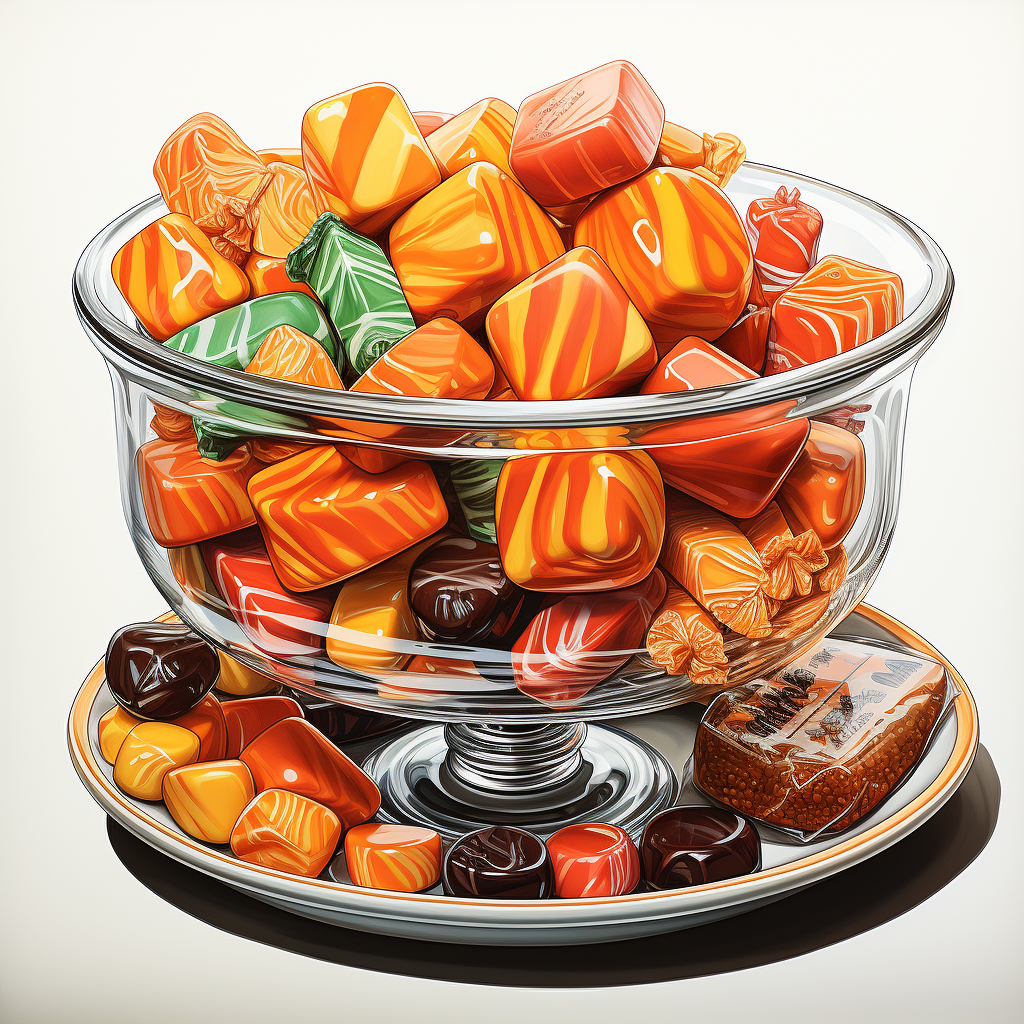
Not every brand has an obvious connection to Halloween, but that doesn’t mean they can’t conjure up a successful strategy. The key is to identify which aspects of the holiday align with your products or services. Understanding what your customers desire during this eerie season is paramount.
For instance, NYX Cosmetics recognized the opportunity to align their products with Halloween’s creative spirit. They dedicated an entire webpage on their website to Halloween looks, partnering with makeup artists to create unique characters and makeup looks. They took it a step further by providing in-store services for applying Halloween makeup looks. This not only promotes their products but also offers a valuable service to their customers, fostering customer loyalty.
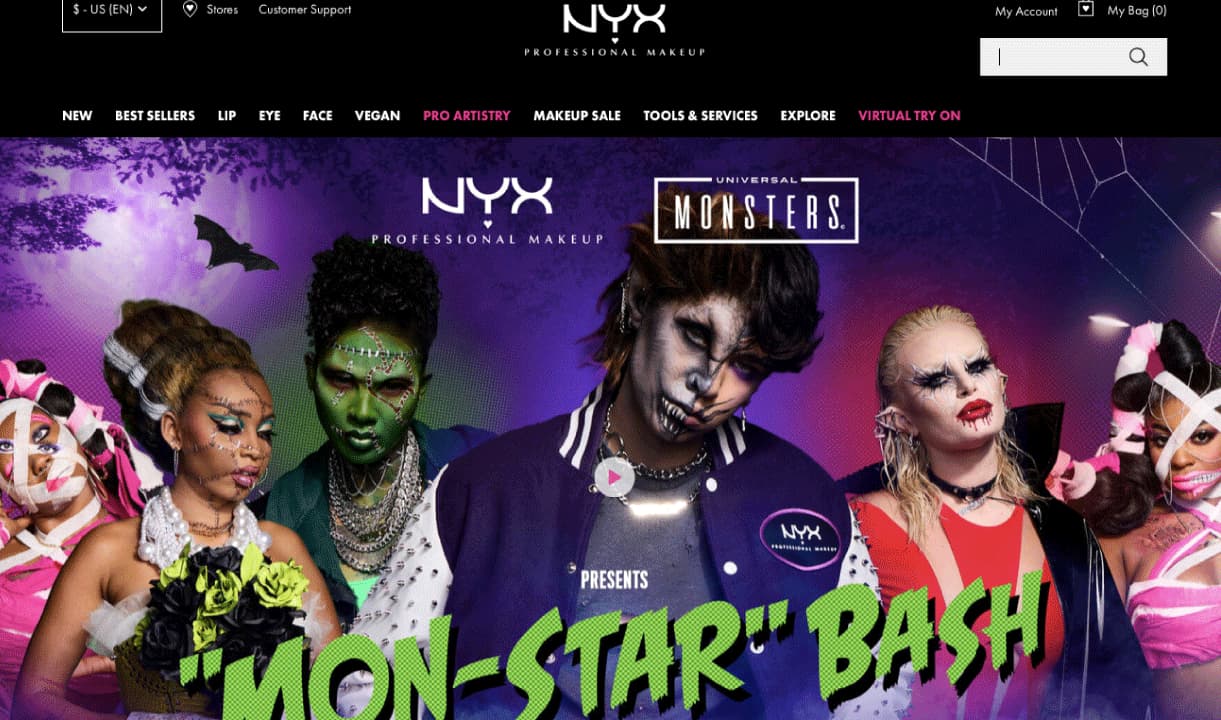
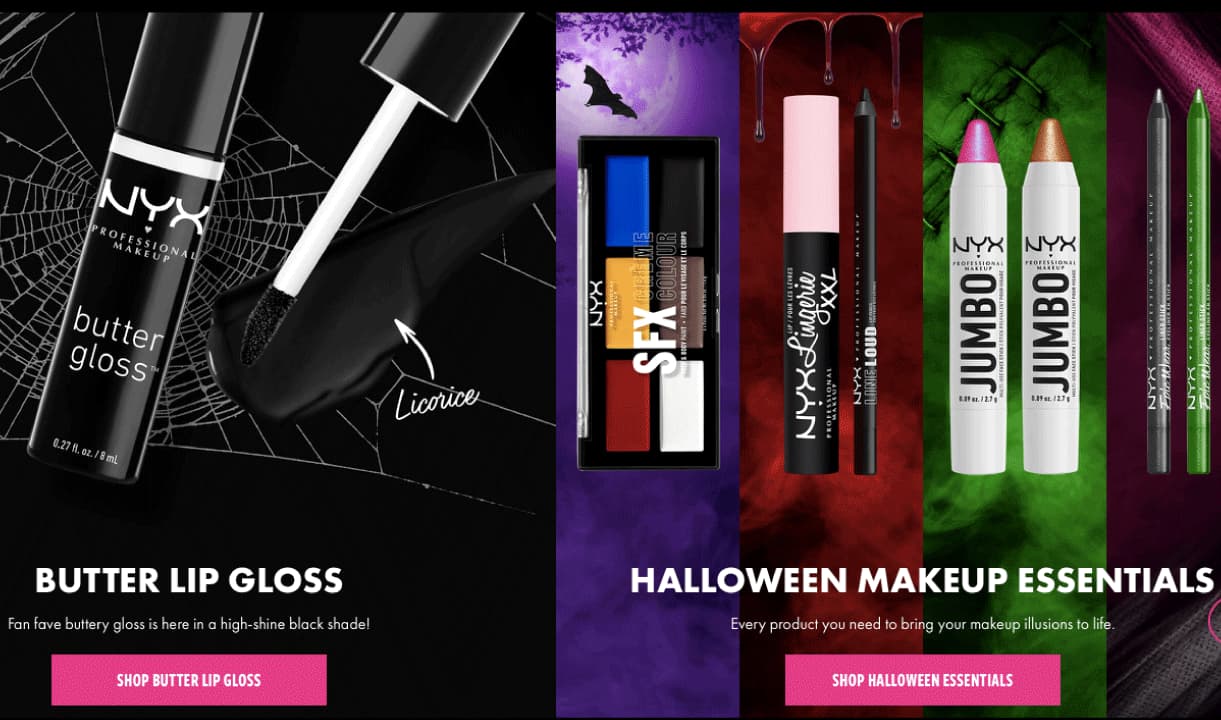
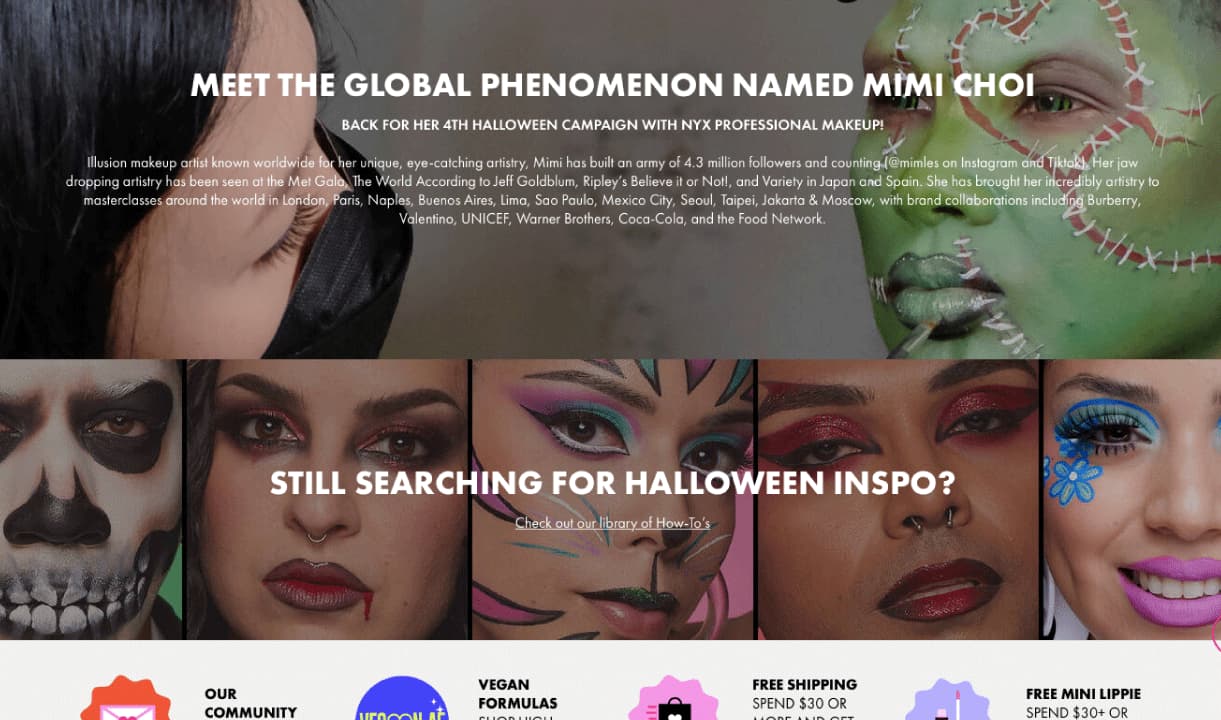
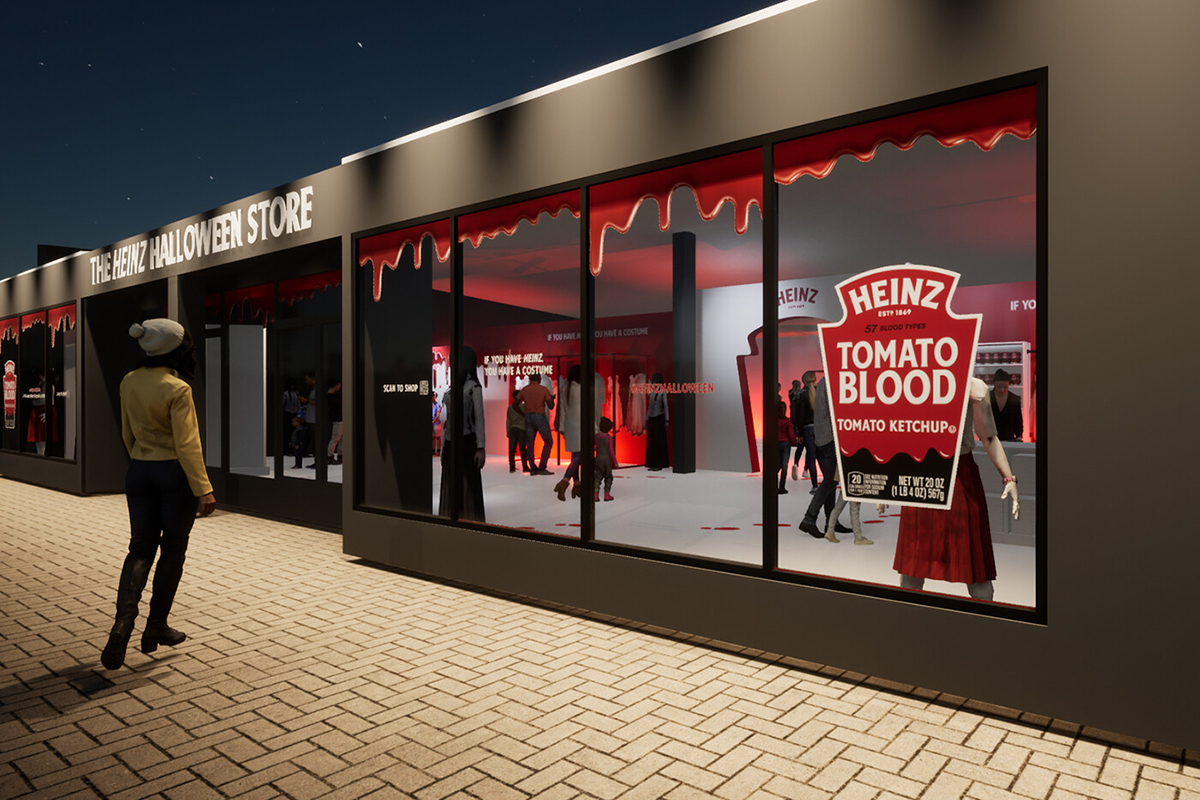
In recent years, Heinz got into the Halloween spirit with a playful twist. They transformed their ketchup into “Tomato Blood” complete with a spooky label, aiming to be a part of the full Halloween experience. To top it off, Heinz set up a pop-up store in LA where people could create costumes using this fake blood and offered a Halloween Heinz Blood costume kit. It’s a good example of a brand immersing itself in Halloween and creating a product connection that goes beyond the ordinary.
Brands are in fierce competition to claim their share of consumer spending, and two critical aspects they need to master are outshining their competitors and grabbing the consumer’s attention.
Holidays offer a prime opportunity for brands to stand out, and Halloween is no different. It serves as the ideal occasion for companies to inject creativity into their marketing campaigns, whether their goal is to spook, thrill, or amuse their target audience. Regardless of their typical offerings, Halloween empowers brands to unleash their creativity.
For instance, in 2017, Burger King playfully taunted their fast-food rival, McDonald’s, with the tagline “Come as a clown, eat as a king“. They offered their signature burger to the first 500 people dressed as creepy clowns, cleverly alluding to McDonald’s mascot. This ingenious move generated a remarkable 2.1 billion earned impressions, illustrating the potent impact of creative Halloween marketing.
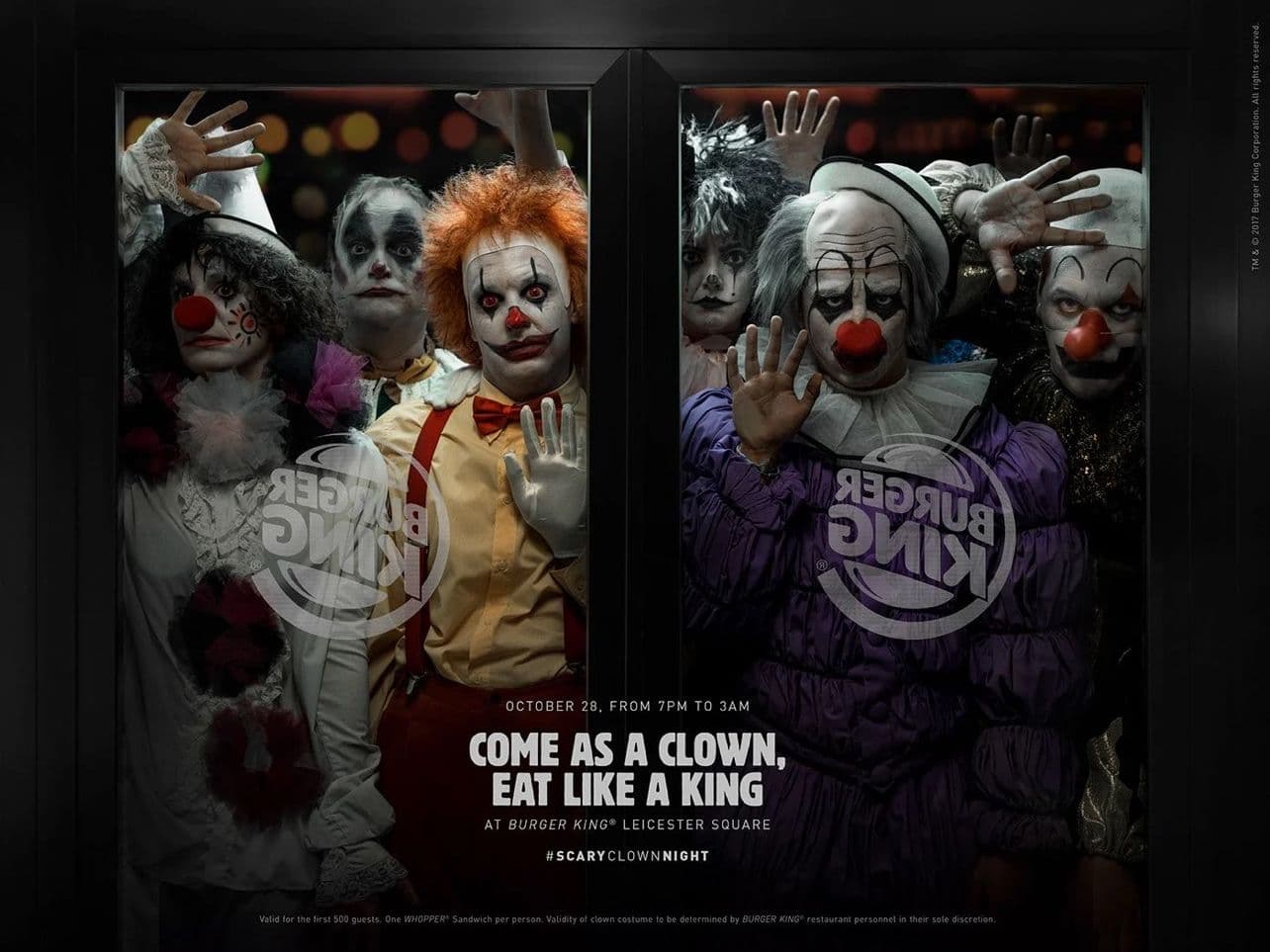
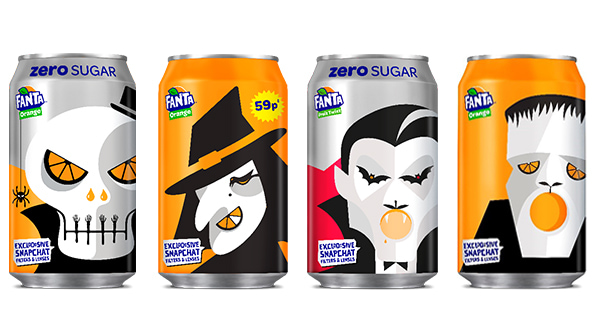
Some even introduce limited-edition Halloween products and recipes to entice consumers to partake in the spirit. Famous for their tagline “Taste the Rainbow,” Skittles embraced the Halloween spirit in 2019 with Zombie Skittles. This product offered five Halloween-themed flavors like Boogeyman Blackberry and Mummified Melon. However, the intriguing twist was that in each pack, one Skittle was the ‘rotten’ Zombie flavor, which pleasantly surprised consumers with a terrifyingly awful taste upon biting into it.
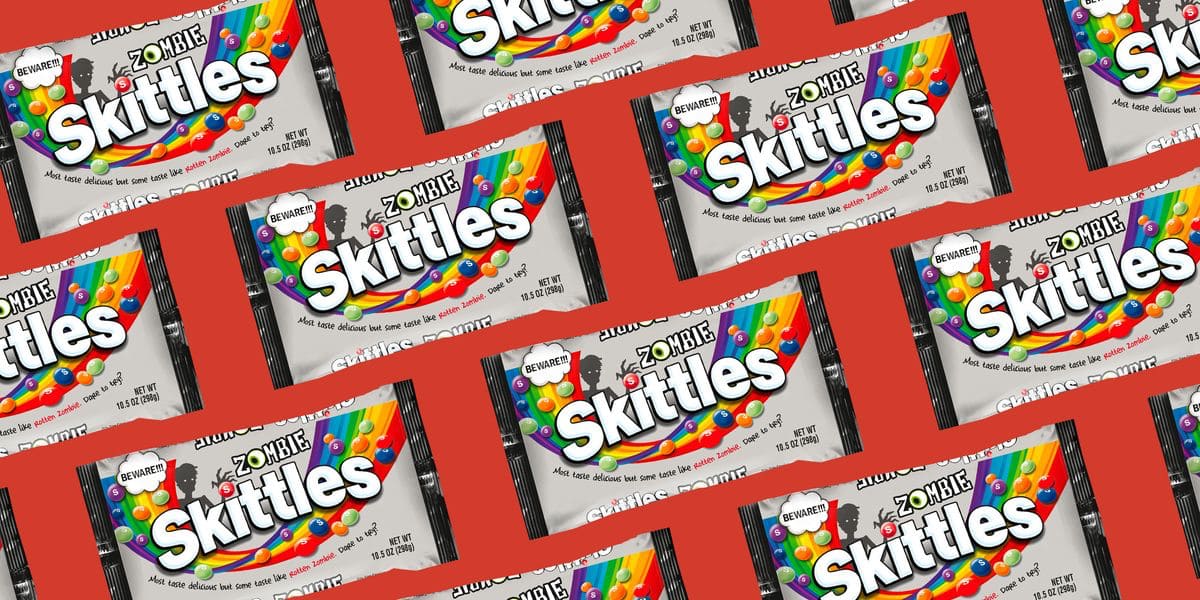
Halloween also serves as the perfect occasion for product relaunches, reviving existing products without the necessity of menu alterations or new introductions. This approach has been embraced by various food companies over the years, with even fast-food giant McDonald’s introducing a fresh perspective on their existing items through spooktacular print ads.
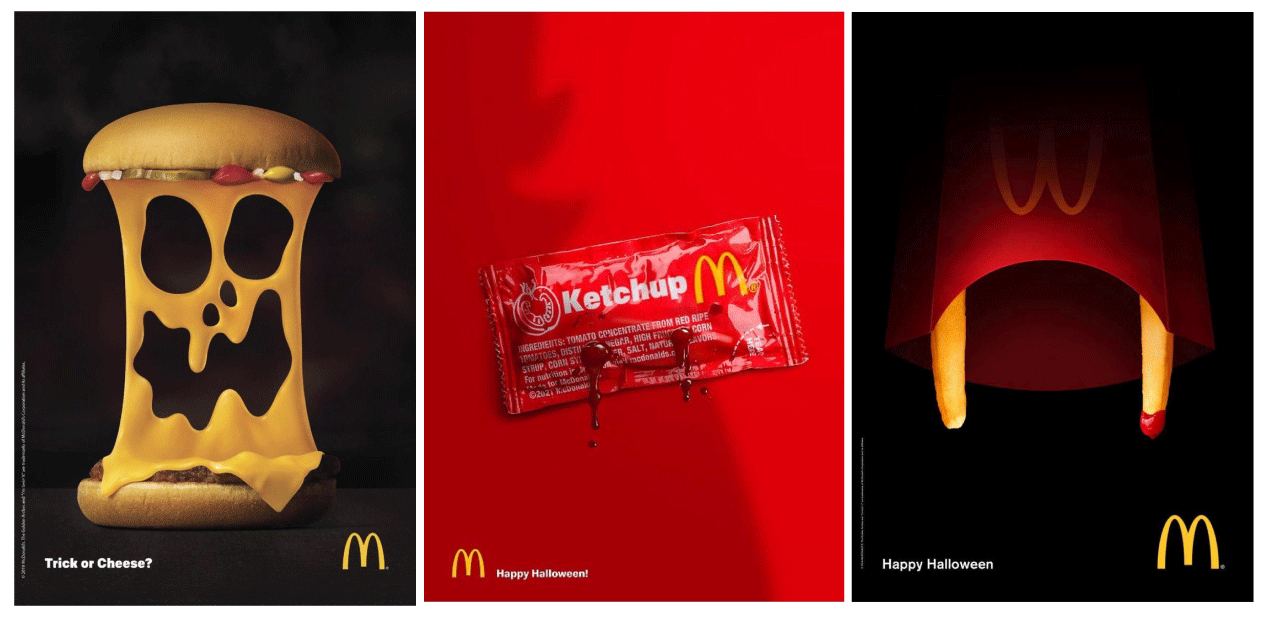
By narrating a story, a brand can breathe life into its products or services, placing them in a memorable context and rendering them more engaging. Regardless of your product or service, storytelling remains the linchpin for consumer attention, and Halloween offers the perfect stage for spine-tingling narratives.
A great example of this is Burger King, who teamed up with Alfonso Gomez-Rejon, one of the directors of “American Horror Story,” to create a short horror film, along with Halloween-themed packaging, to promote their seasonal treats: the Ghost Pepper Whopper and Ghost Pepper Chicken Fries. By seamlessly weaving these products into a horror story, Burger King didn’t just sell a product; they offered an experience, evoked emotions, and established a connection.
Halloween is the season when ghosts come out to play, and with them come boundless opportunities for businesses to thrive throughout October. From innovative packaging design to captivating storytelling, Halloween provides a distinctive platform for establishing memorable connections with consumers and enhancing sales. In essence, Halloween is more about the “trick” in business than the “treat,” where creative marketing strategies abound.
Nowadays, design has emerged as a pivotal force, shaping not only how we perceive brands but also how businesses operate and influence our behavior. We strongly believe in the transformative power of design.
It is more than just a pretty logo or a beautiful interface. It is a powerful tool that can help brands differentiate themselves, have a positive impact on the world, and create value. We are committed to this belief at CBA! Together, let’s explore how design, in all its facets, acts as a catalyst for change in brands and beyond. Eager to deep into it with us? Scroll down!
Design is more than just aesthetic appeal. It is about creating an identity, an ecosystem, and an experience that resonates with audiences. Designers, by using their talent strategically, can give brands extra value. How? By defining and creating unique expressions and experiences, positioning brands to become changemakers.
Design is a powerful business tool that can increase a company’s performance and values. The numbers speak for themselves: design can generate a 87% increase in sales. And that’s not all: 94% of a brand’s first impressions are related to its design.
Elements such as logos, typography, and color schemes play a vital role in defining a brand’s image. For instance, Apple Inc.’s sleek, bitten apple instantly evokes innovation and sophistication, showcasing the transformative power of design in brand identity.
User experience (UX) is a field in which design directly influences the way we interact with brands. It encompasses a wide range of factors, such as product and service design, space planning, and content creation.
UX can have a significant impact on brands and consumers. Let’s take a closer look: the experiences that consumers have with a brand have a significant impact on their perception of that brand. A positive experience can create a sense of trust, loyalty, and attachment. A negative experience can lead to feelings of frustration, dissatisfaction, and loss of trust.
A positive experience can make a brand more desirable and more likely to be chosen by consumers. Consider the transformation brought about by ride-hailing apps, which have made transportation more convenient, efficient, and enjoyable for millions of people by taking a holistic approach that considers the needs and expectations of all users.
By creating experiences that are both useful and inclusive, brands can gain a competitive advantage, improve customer satisfaction, and create a more inclusive world.
Design can be a force for good. Sustainable design is an embodiment of this principle, ensuring that the creation process does not harm our planet. Brands embracing sustainability not only attract environmentally conscious consumers, but also contribute to a greener and more sustainable future.
For instance, Patagonia, a renowned outdoor clothing company, has made sustainability a core element of its design ethos. This is evident in its eco-friendly website, which is hosted on servers powered by renewable energy and uses sustainable design techniques.
In addition, design can play an important educational role in changing behaviors and moving towards greater virtue. Indeed, design can be used to inform and raise awareness, to encourage people to become better in their daily lives through awareness campaigns. Whether it’s through the layout of a store, the packaging of a product, or the design of an advertisement, all of these aspects influence our choices. For example, Apple packaging not only protects the product, but also creates an unboxing experience that elevates the perceived value of the device. We can also mention the “unboxing” experience of the Make My Lemonade brand: once the package is unpacked, the packaging transforms into a stylish home storage box.
Beyond products and services, design extends its influence to lift communities. Social design is about creating solutions to solve social problems, promote inclusion, and positive change. Design can change mindsets by awakening consciences with strong visuals and messages that can appeal to citizens and encourage them to act.
Design is inextricably linked to creating meaning for brands. The story a brand tells through its design elements resonates in the minds of consumers. When design is aligned with a brand’s core values and purpose, it improves its performance.
Nike is a perfect example of what we want to achieve; a brand that has mastered the synergy between design and meaning. The brand is known for its iconic logo, its use of bright colors, and its message of empowerment. These design elements are aligned with Nike’s core values of athleticism, performance, and inspiration. Nike’s use of design to communicate its values and mission has contributed to its success. The brand is one of the most recognizable and profitable in the world.
Design is a powerful force that has the potential to transform brands, business models, and consumer behavior. At CBA, we believe that design is not limited to the visual; it is about creating experiences that resonate with the public, align with values, and drive positive change. Design is a powerful tool that can be used to make a difference in the world. By using design thoughtfully, we can contribute to creating a more just, sustainable, and inclusive world.
Design is a global language that connects like-minded people, and its role is to establish a meaningful dialogue between brands, cultures, products, and services. Brand experience is the lasting impression customers have of your brand, it’s when brands come to life. This experience includes thoughts, feelings and reactions that go beyond product purchase, and present the brand in a different way.
How can design help building a stronger and more consistent brand experience? To broaden the experience that a brand can offer, and to inspire you with design solutions for consumer goods, we have analyzed a couple of references and brought you some insights and examples:
Design is not just about visual elements, but also about creating a multisensory experience for customers. This can include using sound, touch, and even smell to create a more immersive brand experience.
Explore the brand assets all the way, inviting the audience to see the world through the brand’s unique perspective. Think of your product shape as a portal to a large ecosystem… Ask yourself questions such as ‘Is there any singular characteristics of my brand I should explore?’ or ‘If my brand dropped the logo or wordmark, would people still recognize it?’
The 5 senses open a gate of multi sensorial experience that creates a powerful emotional bond that people will never forget – and they will never see your brand the same way again.
The Greatest
Apple highlights its innovative features such as door detection, sound recognition, and voice control, which enable individuals with disabilities to customize their user experience.
Packaging is not just a functional element, but also a canvas for storytelling and brand expression. Brands can use packaging to convey their brand story, values, and personality, creating a deeper connection with customers. Never underestimate your packaging potential to communicate uniqueness and ultimately engage with your audience.
Infuse storytelling on pack. Dare to use the packaging as a canvas to tell customers your campaign or your brand story. And never underestimate the back panel or the inside wrapper to express the brand’s point of view.
The pack can be the starting point to spark conversations and to stimulate everyone to express positivity, creating content and powerful social campaigns.
06 Packs help you get your Valentines crush ♥️
For Valentine’s Day, Monoprix offers a unique way to make declarations of love by creating ‘Pack 06‘ on which customers can write their phone number and then place them in their crush’s shopping cart at the supermarket.
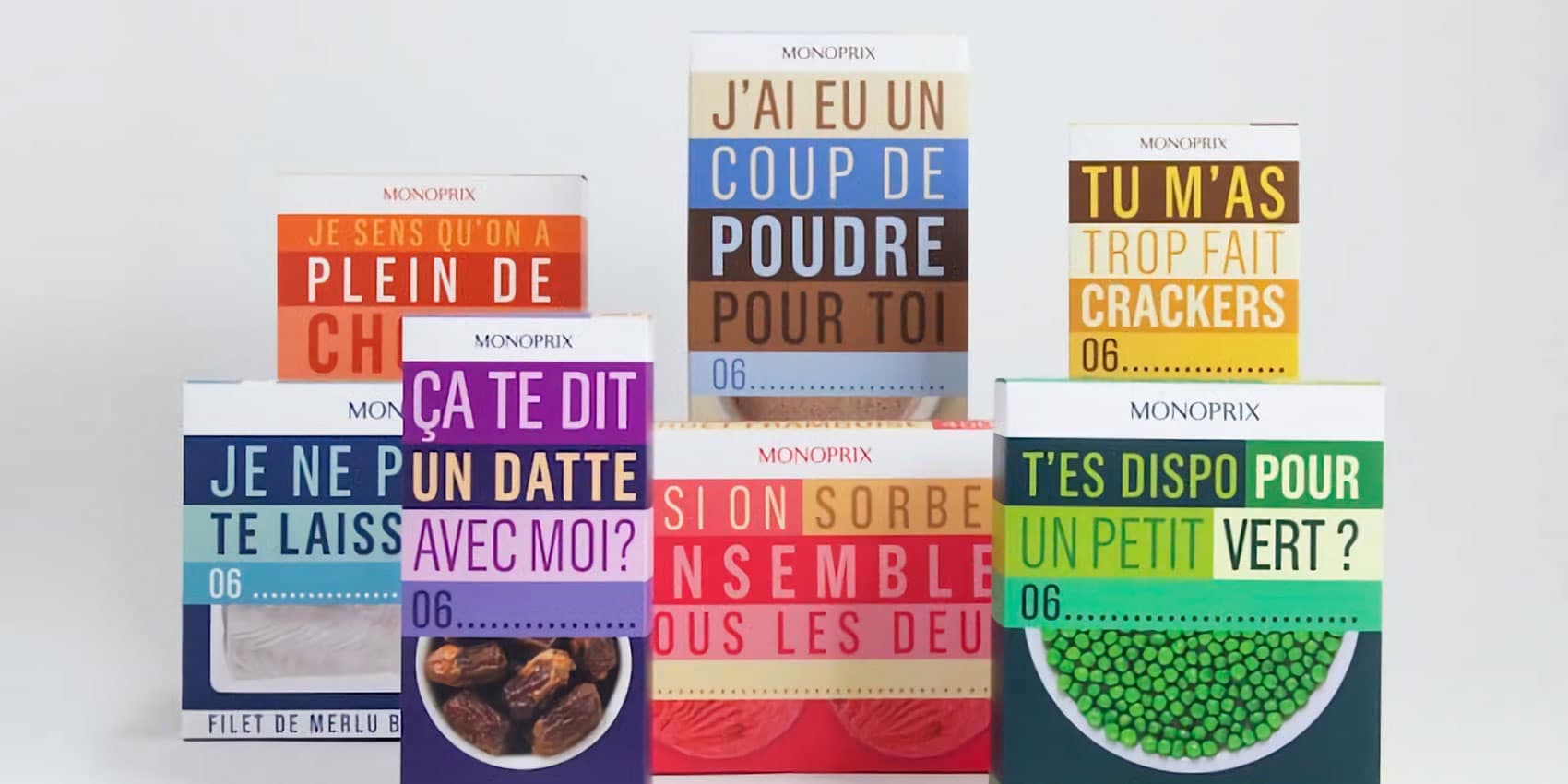
An increasingly important factor in brand experience, as customers are looking for brands that are environmentally and socially responsible. Brands can use sustainable packaging materials, design for recyclability, and communicate their sustainability initiatives. Innovative, yet simple design solutions to become 100% eco-friendly and revolutionize the industry.
Global brands are embracing strong commitments with sustainability and showing them to the world with powerful aesthetic retail experiences and brand environment, using innovative design and powerful storytelling.
Get your customers to engage with your recycling and sustainable programs through rewarding schemes and hassle-free experiences that make it easy for them to participate.
Doing good with goodness
CBA Design partners with VALRHONA in the creation of its space in the heart of Paris. With the goal of highlighting the Maison’s CSR commitments, the Retail & Architecture department has prioritized eco-friendly materials, including coated raw earth, cocoa bean waste, and wood wool panels.
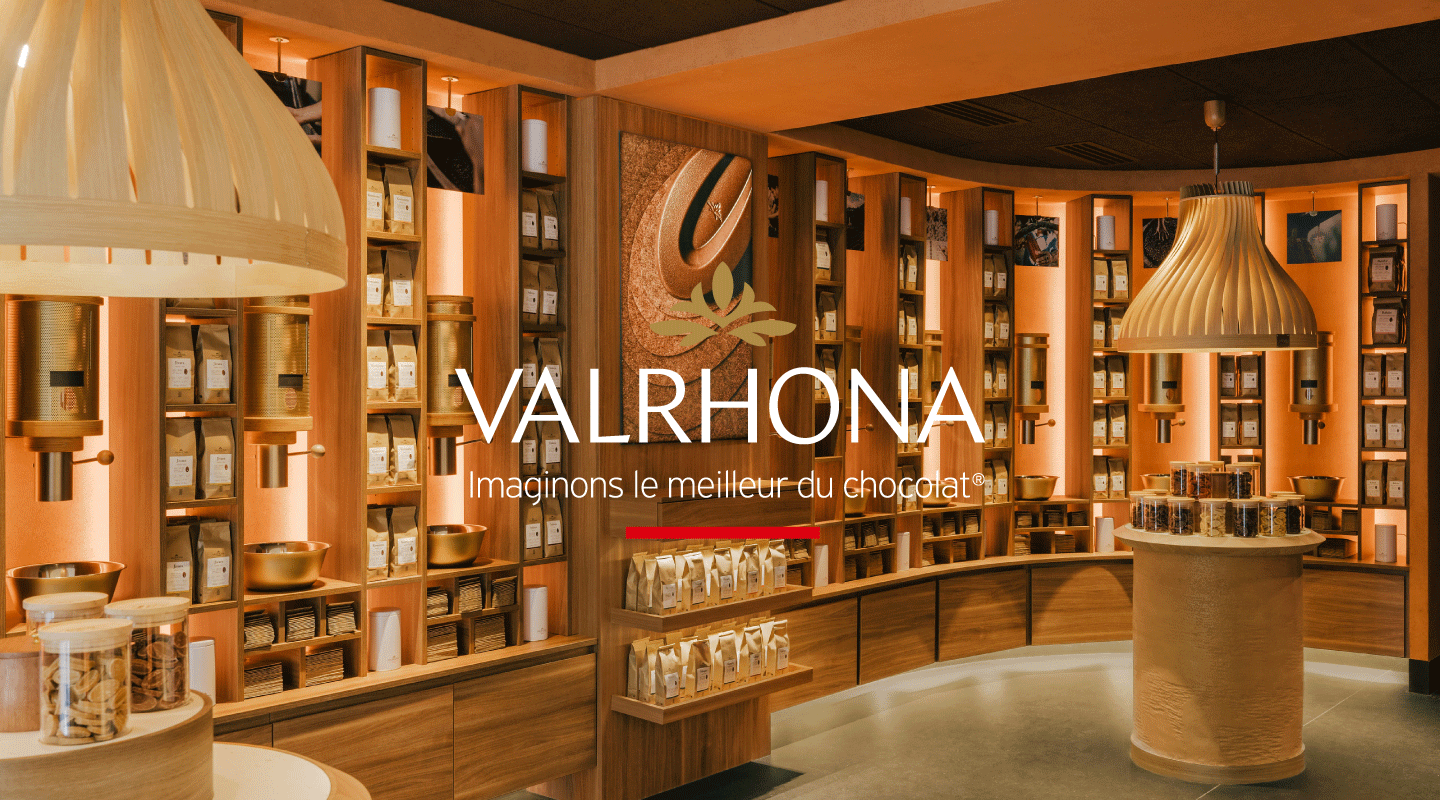
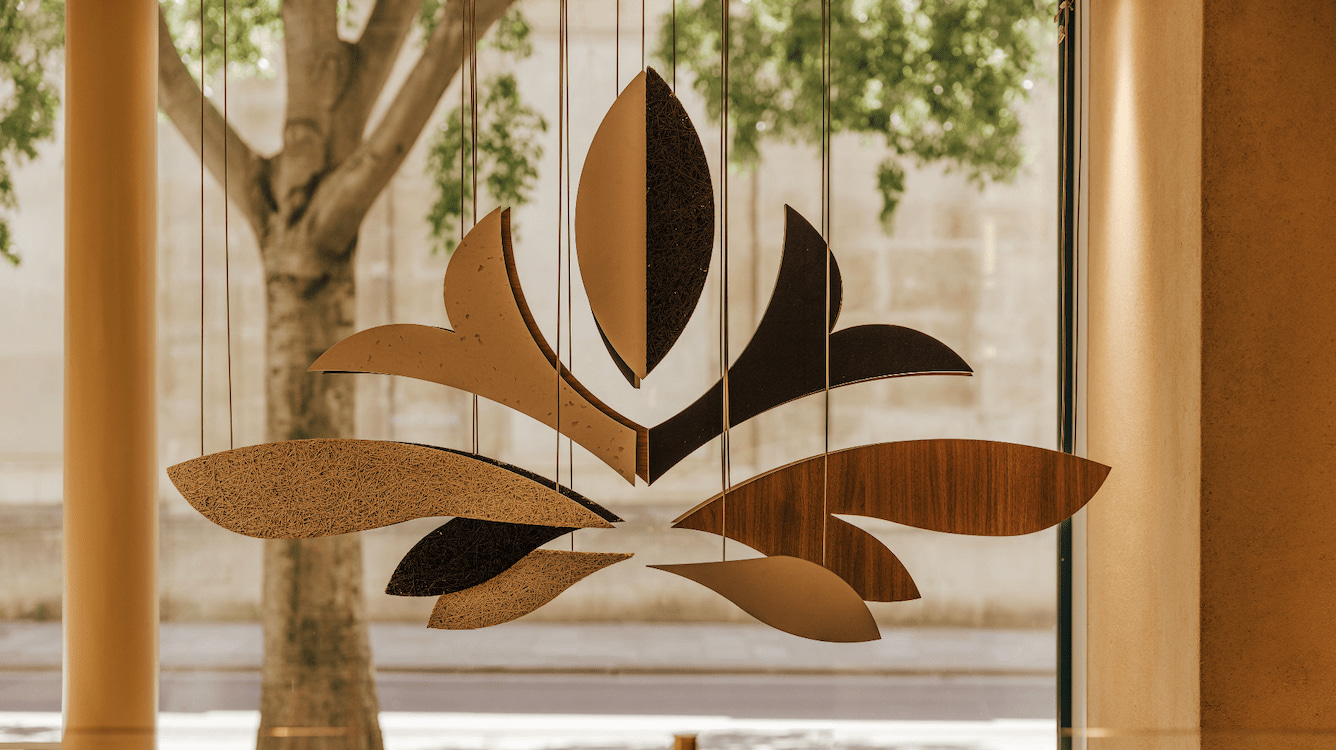
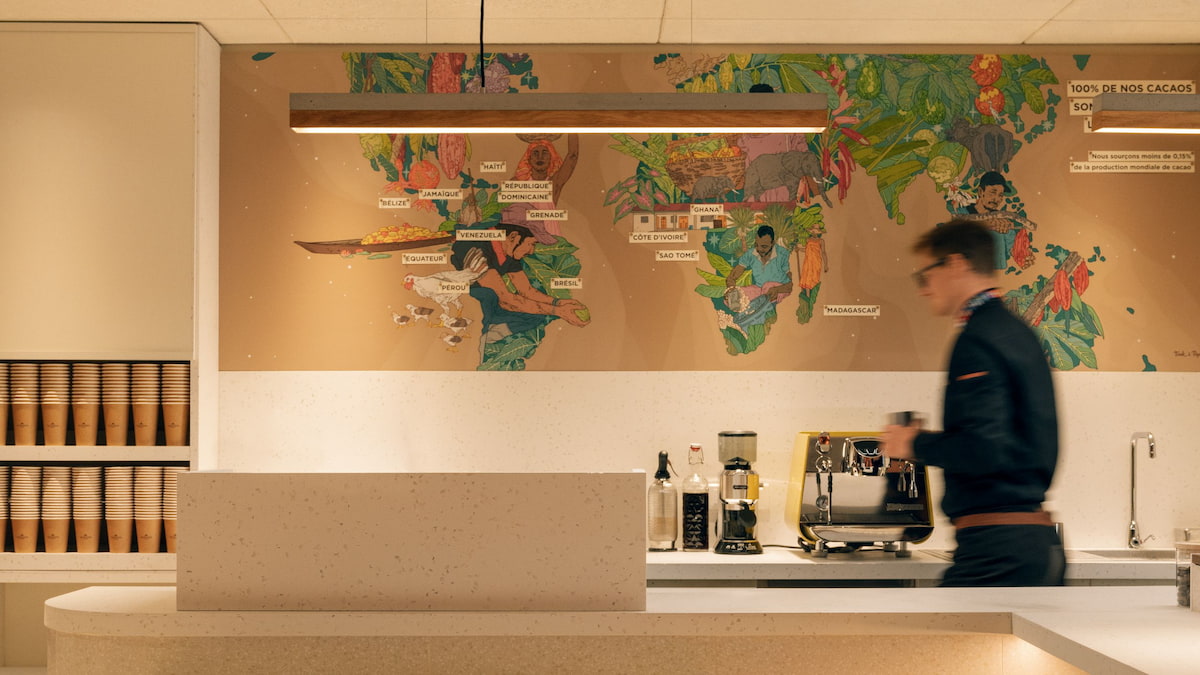
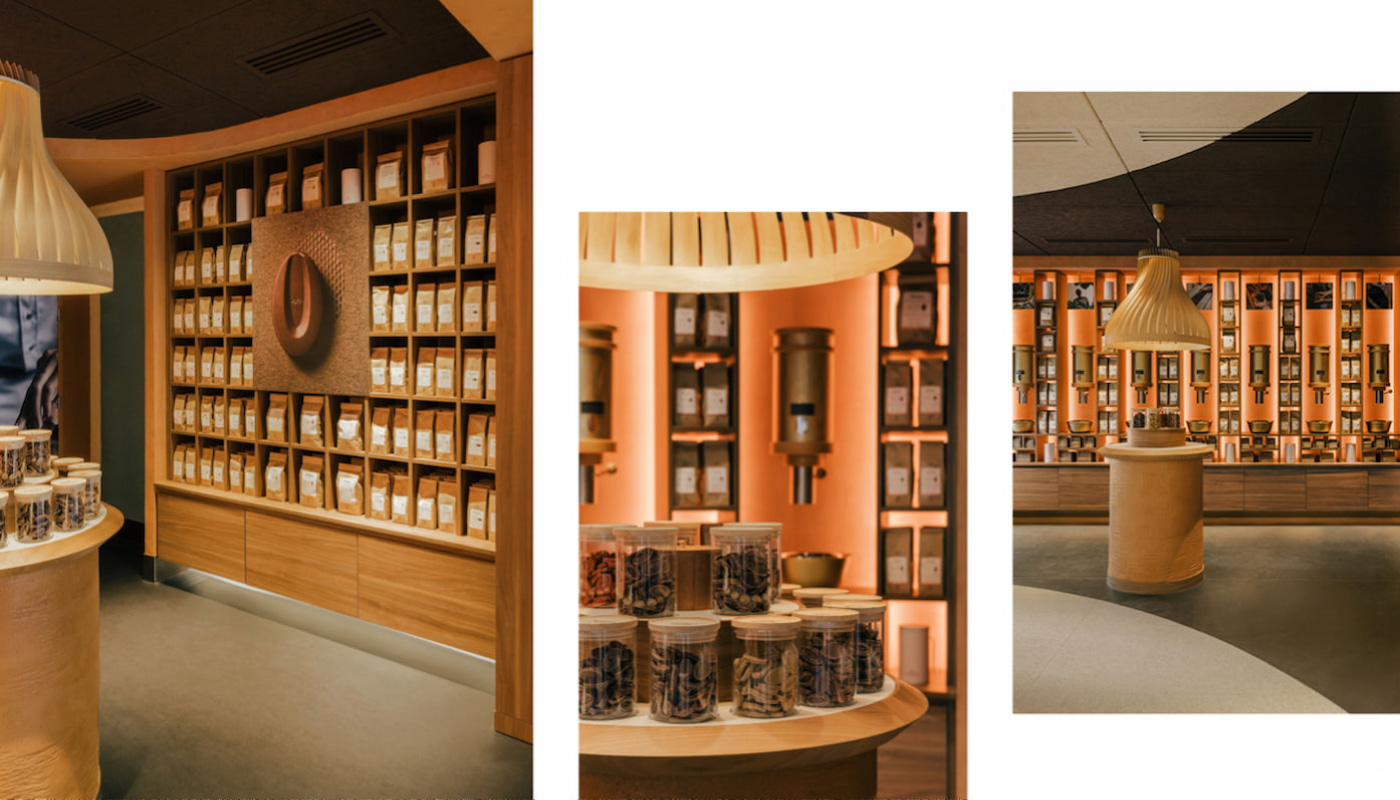
The digital world offers endless possibilities to create desirability, with one-of-kind digital collectibles and hybrid experiences that add an interactive layer in the traditional store format. By bringing the digital to the physical, we can create unique and memorable experiences.
You can create unique digital collections of your products that can help increase the value of your brand, making it more iconic and desirable.
Retailers are bringing the metaverse into the physical world. Others are using metaverse, to reinforce the unrivalled value of IRL experiences.
Heineken Silver, the zero calorie beer
The Dutch beer giant unveiled its new beverage in its virtual brewery on Decentraland, its metaverse platform, making it the world’s first virtual beer.
It is a powerful tool for amplifying brand experience. It allows brands to connect with customers in real-time and create a sense of community. Brands can use social media to share user-generated content, respond to customer feedback, and create engaging campaigns that encourage customers to share their experiences.
Netflix, decoding a successful digital strategy
The undisputed global leader in streaming owes its reputation in part to its exceptional marketing strategy on social media, a way for Netflix France to engage with its community using a playful tone and leave a lasting impression.
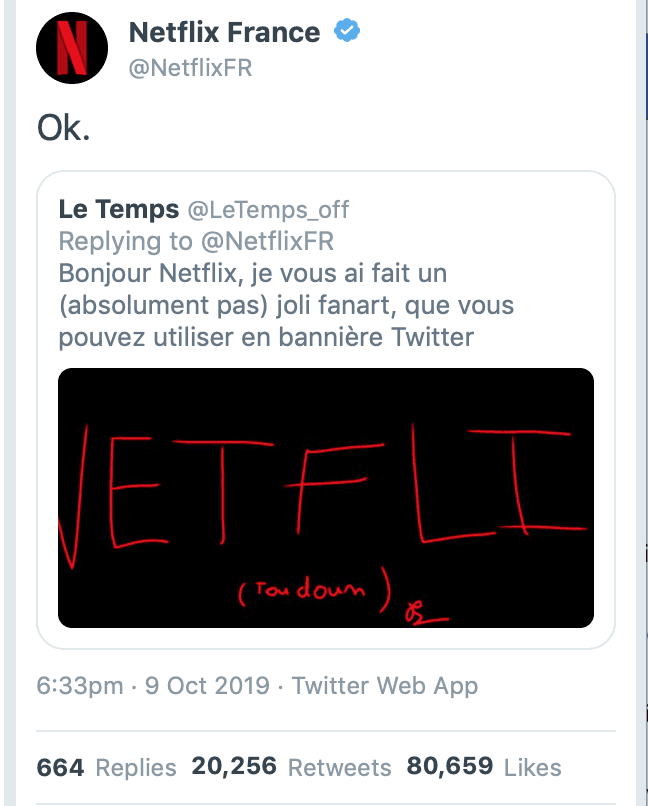
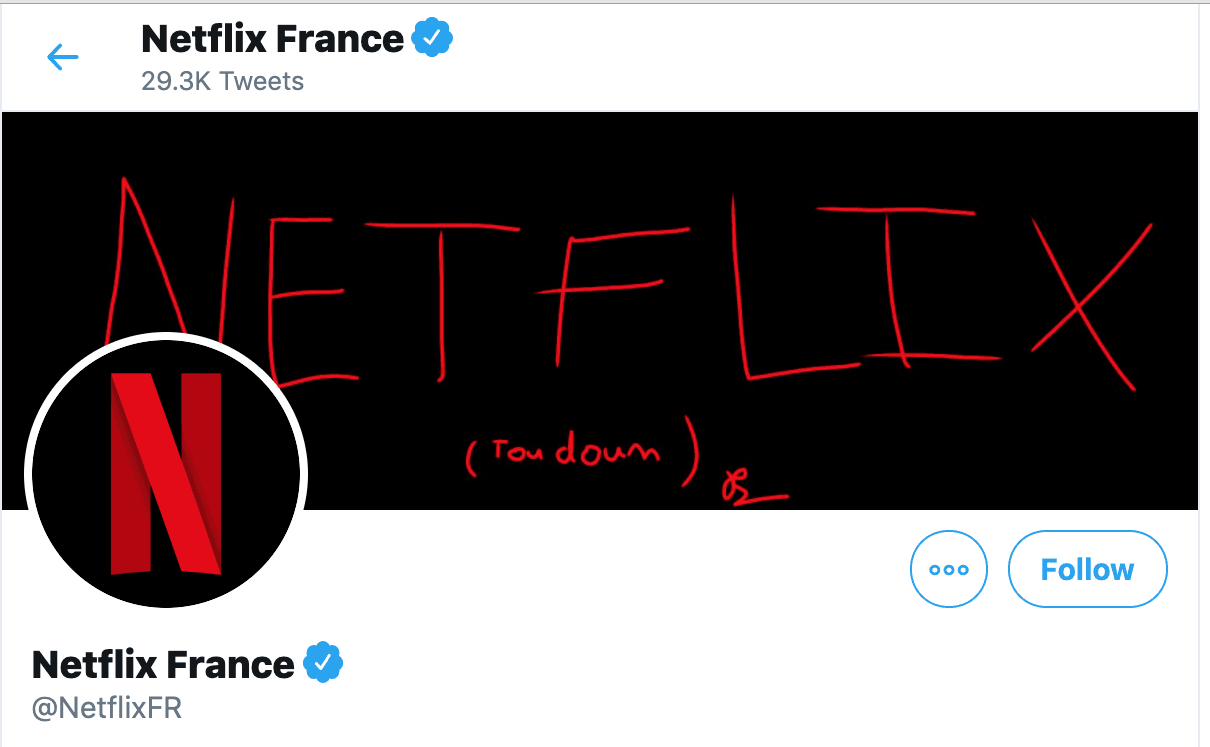
Every aspect of a brand – verbal or visual – should work together to create a cohesive and memorable experience. From graphic to business design, we believe that design foremosts a way of thinking that uses specific methodologies to solve problems based on consumer experience.
We work beyond the surface of our clients’ businesses, fully meeting their needs through projects that include branding consultancy for FMCG, service design, marketing, and business modeling.
Artificial intelligence (AI) has firmly established its presence in our lives, permeating every corner from self-driving cars to voice-activated assistants like Siri. Beyond our daily routines, AI’s influence extends into various industries, including design. Recent advances in AI have transformed the way we conceive and create products, services, and spaces. While AI offers innovation and streamlines design processes, it is essential to remember that it is, after all, a tool – an assistant rather than a creator. This leads us to the intriguing question: “To what extent is artificial intelligence a complementary tool for design?”
In the world of design, inspiration is the spark that ignites the creative process. AI, with its generative tools like Adobe Firefly, has become a beacon of hope for those who have wrestled with the dreaded blank pages. These AI-powered tools provide creative individuals with a starting point, generating text-based image suggestions that serve as a foundation for their projects. They act as valuable complements to human creativity, breaking down barriers and facilitating the realization of ideas. Whether you’re a product designer, architect, or working in any other creative field, AI can enhance the ideation process and foster creativity.


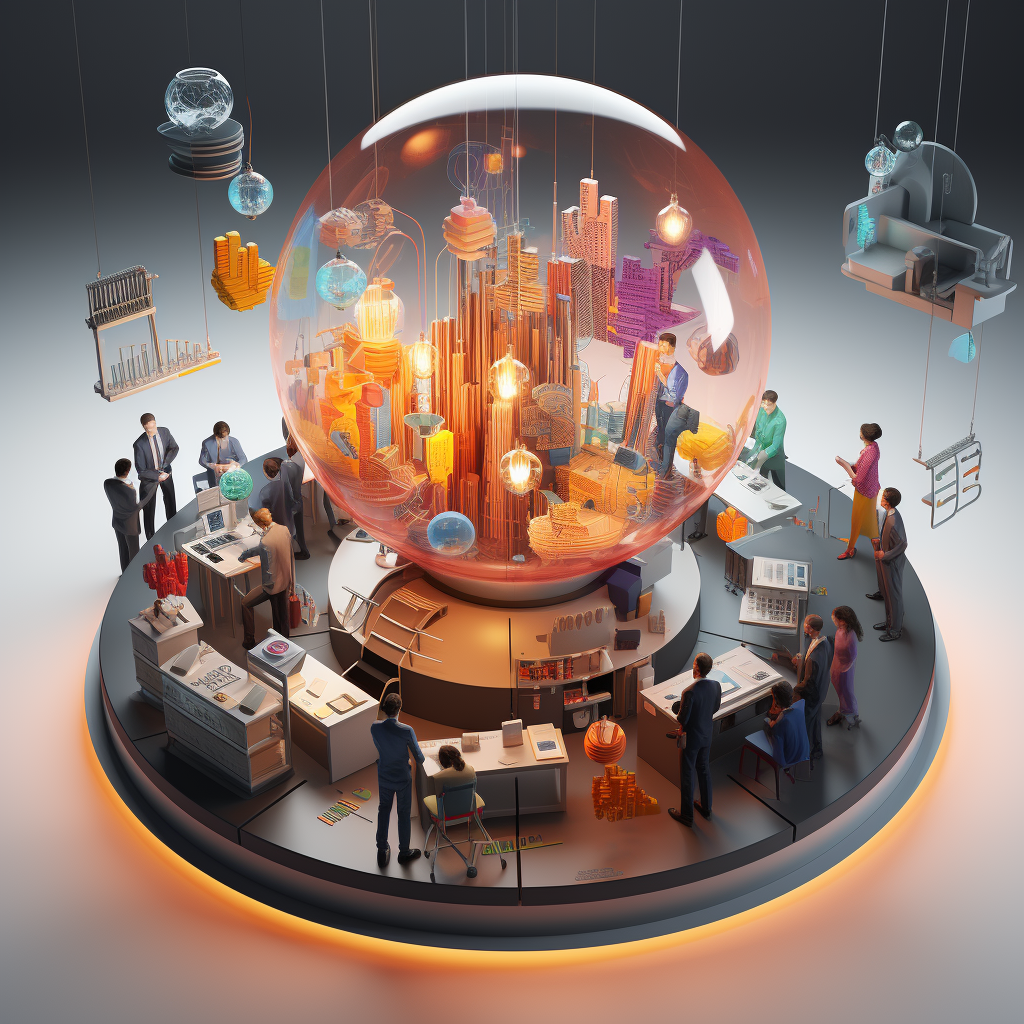
is that it can help you get out of the blank-sheet syndrome. Do you have an idea? You don't need any knowledge, even graphic knowledge, the model will be able to bring it to life visually.
AI empowers designers to extract valuable insights from user data, guiding their design decisions. By analyzing extensive design databases, identifying prevailing trends, user behavior patterns and preferences, AI can offer informed recommendations on design elements, layouts, and visual styles.
AI’s influence on design extends to automating various tasks that previously consumed valuable hours. From generating layout options to selecting color schemes and suggesting typography, AI-powered design tools expedite the design process and enhance productivity. By automating repetitive tasks, AI liberates designers to focus on more creative and strategic aspects of their work.
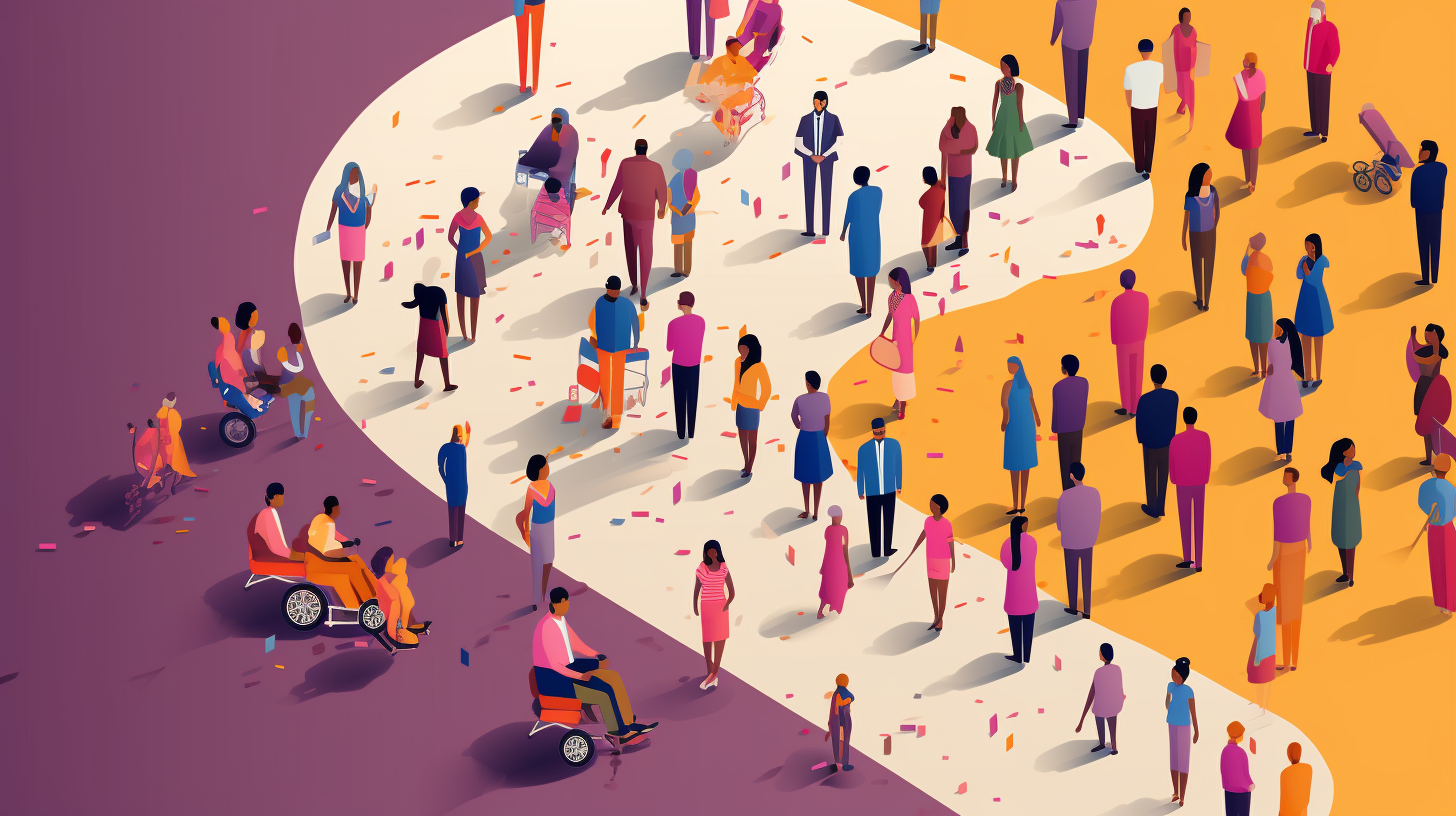
While AI offers remarkable potential, there’s one area where it still faces challenges: inclusivity. AI systems often rely on data that may not accurately represent the world’s diverse population. This can lead to systems biased against certain groups of people, such as people with disabilities, minorities and marginalized populations.
For example, Amazon experimented with the use of AI to automate its recruitment processes. The aim of the program was to examine candidates’ resumes and assign ratings ranging from one to five stars, in order to simplify profile selection. However, the computer model used by the company was based on resumes received over the last ten years. This approach had an unintended effect, given that the data used primarily came mainly from male applicants. The AI was therefore trained to prefer male profiles, putting female candidates at a disadvantage. This case is just one of the examples that illustrates a major problem when using AI: the bias of the training data, which can lead to biased results.
However, addressing bias and ensuring inclusivity remains a crucial challenge for AI, but it is not the only one. With many questions / limitations like inclusivity, copyright and credibility and reliability of information sources, AI may not be perfect today, but potential of this evolving technology feature is promising. As we witness its evolution, one thing is certain: the future of AI in design is brimming with exciting possibilities.
At CBA, we asked AI if it can replace designers in the near future. Its response is clear:
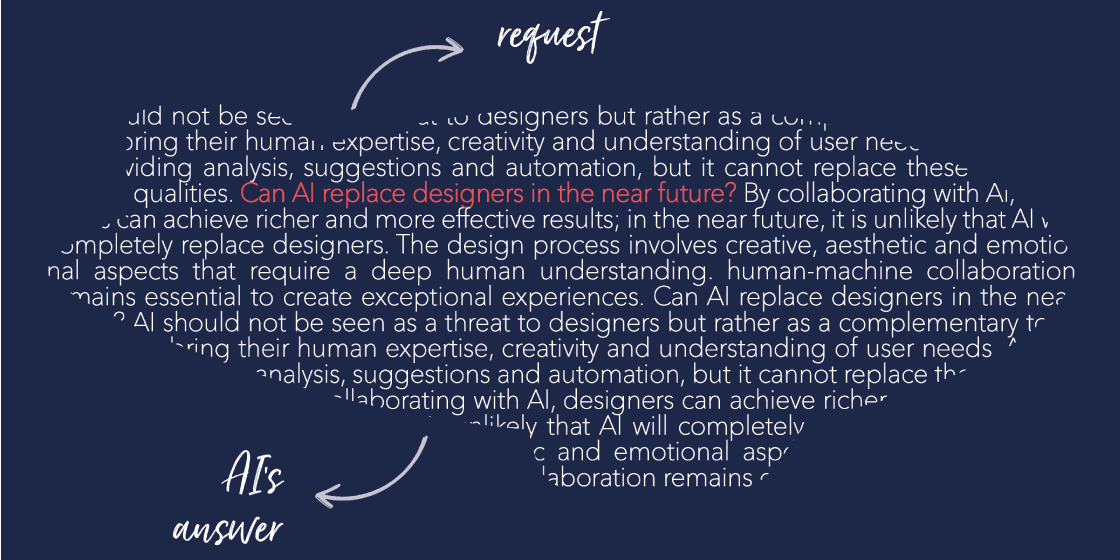
"AI should be seen as a complementary tool for designers. Designers contribute their human expertise, creativity, and understanding of user needs. AI can assist through analysis, suggestions, and automation, but it cannot replicate these essential human qualities."
ChatGPT
The design process is a multifaceted tapestry, demanding the richness of human creativity, aesthetics, and emotional depth. Therefore, AI stands as a facilitator of creativity, with true creators being the humans who guide it. At CBA, we cherish the symbiotic relationship where AI and designers work hand in hand, augmenting each other’s strengths. As AI becomes an integral part of the design landscape, our unwavering belief remains that the human touch will always be the most essential element.
Many of the startups and entrepreneurs that we are lucky to work with are engineers and product developers who are responsible for some truly remarkable innovations. They’re “idea” people who are able to turn ideas into hardware, software and theoretical Unicorns. They’re brilliant. In the early years of their business, their teams are lean and scrappy. They build and iterate and prototype and drive their friends and families crazy with ideas and decks and pitches. And by the time they show up at our door, they’re eager to bring their business to market, but they need a branding and design agency’s help to do so.
9 times out of 10, this is the point at which entrepreneurs provide us with a brief for their logo. In their minds, this visual mark provides the much needed validity that will enable them to sell their idea to a room and help investors envision their idea as the next big cash cow. Much to their chagrin, this is also the point at which I explain to our entrepreneurs that brands are like icebergs. A logo is but the tip of this iceberg, whereas the heart of the idea lies submerged under water. To make a consumer – or a room full of investors – fall in love, you need the sum of these parts: the full brand.
More often than not, startups struggle with this concept. Many feel that the challenge and cost of conducting a branding exercise is prohibitive. As a result, these clients crowdsource logos or a singular piece of packaging design or collateral which they lean on to support their business as it grows. But this mentality is flawed and is often the most expensive route a company can take; we’ve seen countless companies stumble and fall when they underestimate the role of brand and fail to invest in it.
Much like a startups’ consumer doesn’t fall in love with the lines of code that make up a piece of tech, neither do consumers fall in love with a logo alone. Instead, what wins the hearts and minds of consumers is the combination of code, visual language and story all rolled into one beautiful brand. And while these entrepreneurs are often horrified to hear that we recommend investing the two things they have so little of – time and money – into building their brand the right way, we have seen first-hand the power of “brand” in cementing a startup’s success time and time again.
Here are 3 ways in which early investment in brand can make all the difference for startups looking to stand the test of time:
Many startups are started by young engineers who are, without a doubt, brilliant individuals. But these same individuals often clam up when it comes time to talk about the emotional connection to what they were building. This lack of emotion can be a quick and fatal error. A good product is one thing, but without a story or a reason for believing in your product, your business simply cannot thrive. Emotion is the fastest way to build brand loyalty with consumers, and desire is the strongest emotional of them all. Even the best product will not succeed if no one wants it.
Startups that sit at the crossroads of “desirable brand” and “exceptional product” will forge long lasting emotional connections with their consumers. This connection means loyalty in good times (and shaky), improves the likelihood of word-of-mouth ambassadorship, and inevitably sets up a solid foundation for growth. A great example? While many of its competitors has superior technological capabilities, Apple’s lifelong commitment to brand ensures that their product is the most desirable, and thereby the most successful.
Another common hiccup for startups is their hesitation to create a brand before they have the security of a fully fledged product line. And while the logic in that is relatively sound, it’s forgetting one key reality: every good product company has pivoted and reinvented itself, for which there is an essential ingredient: a strong brand.
A brand is the medium through which a startup can express a desirable and sustainable vision to both investors and consumers. It’s that brand that tells a long term story that transcends product and allows audiences to buy into a bigger vision. And it’s this brand that should act as the North Star long after that first beta product launches. As much as it can be hard for our clients to hear, brand cannot be secondary to product – the two must go hand in hand.
If you are not a brand, you are a commodity. Then price is everything and the low-cost producer is the only winner.
—— Phillip Kotler
A few smaller clients are excited to invest in their brand, but they consider that to be their logo, the look of their website, or their packaging. While these are important components of any good brand, they’re not comprehensive and usually won’t support long term growth. While entrepreneurs can be tempted to embrace short term opportunities because they are facing cash flow issues or lack of interest from investors, it’s vital that they consider their long game before doing so.
With a strong brand in place, it is significantly easier to do this. A clear brand foundation provides a clear roadmap for the business, allowing entrepreneurs to continually vet and develop successful opportunities. Moreover, branding builds more than just desire and security on the consumer side, it also affects the internal value of a company. The best consumer brands in the world are also some of the best to work for because that brand runs deep in their D.N.A. Driven by the mission and the values of the brand, the company purpose comes alive and the company is able to build a strong and covetable culture.
Companies pay too much attention to the cost of doing something. They should worry more about the cost of not doing it.
——- Phillip Kotler
In an era where natural resources are overexploited, brands are expected by consumers to incorporate more responsible practices to facilitate mindful consumption.
Sustainable design thus becomes their best friend in successfully championing this cause! However, the recurring question is: is this greenwashing, or a genuine employer brand promise?
Here are the aspects to pay attention to in order to determine if a brand is truly sustainable over time. Let’s explore!
According to Ipsos, nearly 60% of French consumers plan to eliminate excessive packaging to fight climate change. That’s why companies are even more encouraged to innovate and rethink the way they design their packaging! The sustainability of packaging allows brands to reduce their environmental impact throughout the lifecycle of the products they offer.
How to determine sustainable packaging?
Beyond informing consumers, an eco-designed packaging also communicates the brand’s identity and values, enhancing its reputation as a committed player. Sustainability of materials, transparency of origins, and supply chain traceability have become essential today.
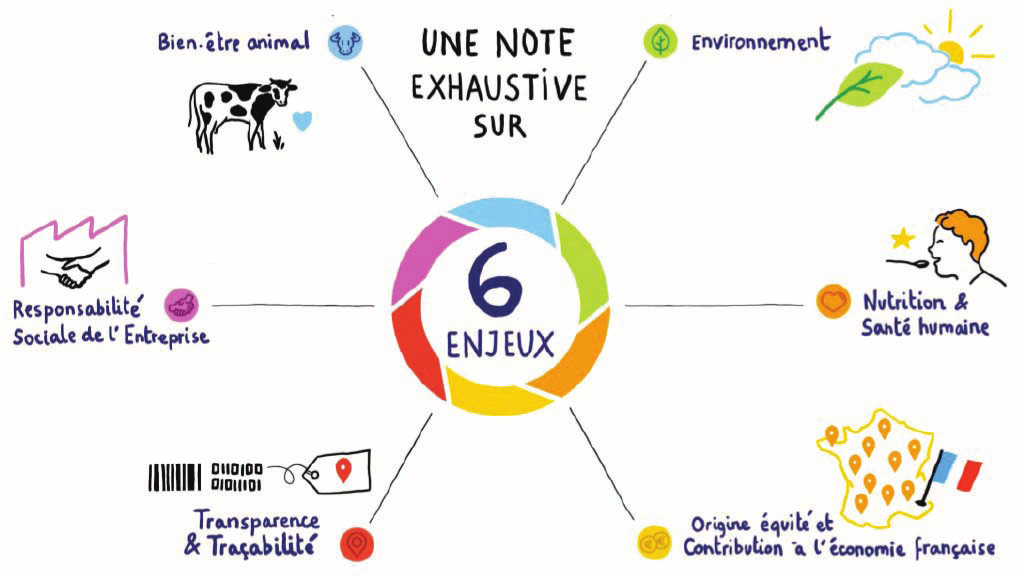
Let’s focus on La Note Globale (The Overall Score, in french), the first benchmark for the overall performance of food products calculated based on 6 criteria: animal welfare, environment, nutrition, origin, traceability, and corporate social responsibility (CSR).
By revealing the “hidden” attributes of a product, it empowers consumers to choose the one that best aligns with their personal expectations.
By combining creativity, functionality and sustainability, design offers new perspectives to rethink our way of producing, distributing, and consuming food.
If you thought that sustainability only applied to packaging, think again!
Visual identity, logos, and even the graphic identity of a brand can also be part of sustainable branding: one that goes beyond a company’s visual appearance to integrate practices that preserve the environment and promote social responsibility.
Why sustainable branding?
Did you know that, to achieve a beautiful pine green in printing, a CMYK ink coverage of 209% is required? 👀
However, despite being the color of sustainability, the ink coverage needed for green is significantly higher than 100%. Greenwashing or not… we’re not that sure!
On the other hand, for web applications, it’s advised to use colors like black or red, generally darker shades. In essence, the opposite of print! And why? Simply because these colors require less energy to display on screens.
Useful information, isn’t it?
Sustainability has also made its way into our favorite stores!
As a rapidly transforming sector, retail has adapted to ecological awareness by incorporating eco-responsible practices into all aspects of the retail sales process. From products sold to construction materials, sustainable retail fully participates in the CSR initiatives of the brands that have embraced it.
And brace yourselves: beyond the mere aesthetics of products, sustainable retail also influences the overall shopping experience and consumer habits!
But how?
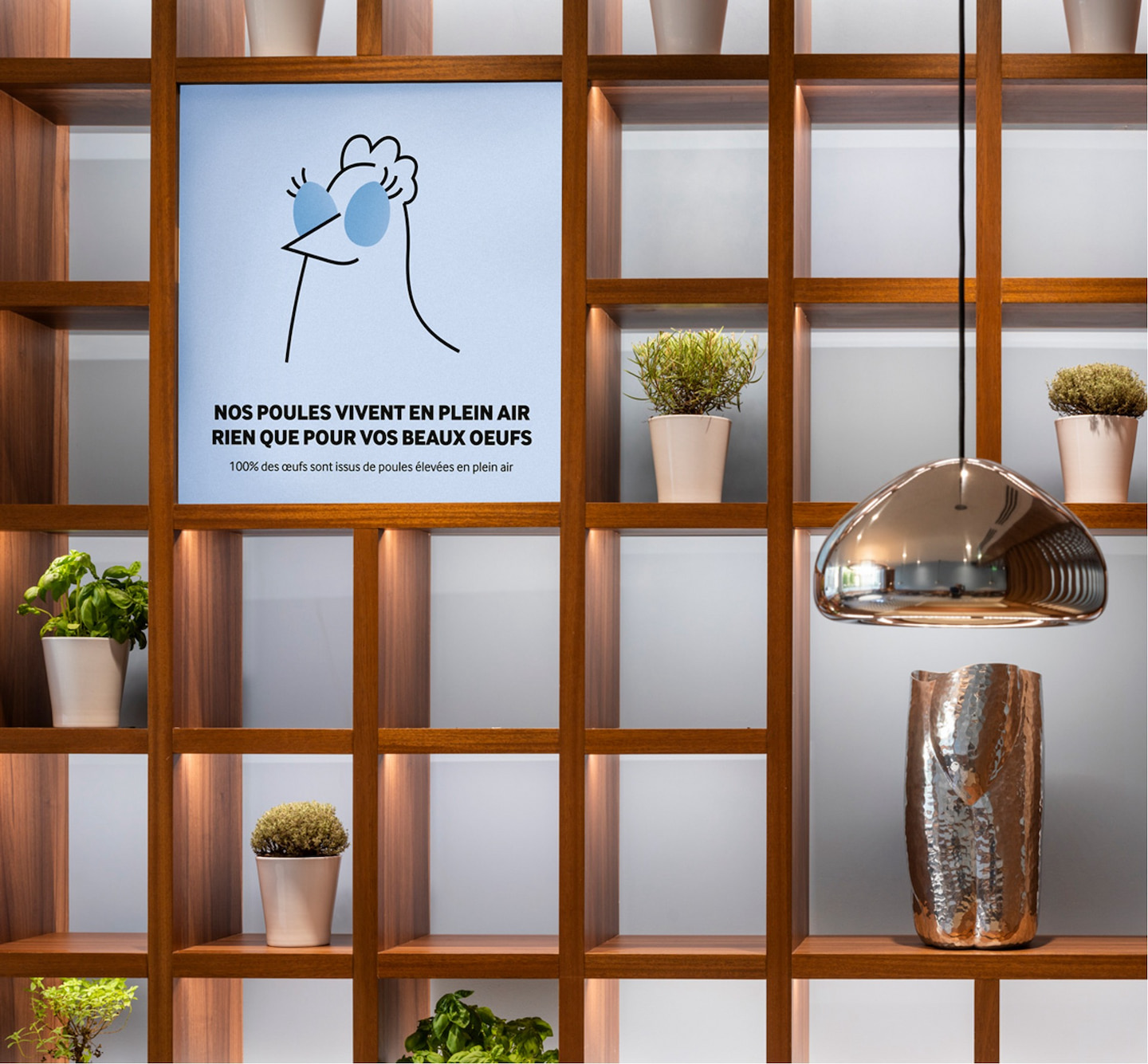
Focus on Cojean, the French top-of-mind in healthy fast food, for which CBA developed an overall identity system that reflects the brand’s CSR commitments.
This visual concept is also extended to the retail concept of their stores in Paris.
The goal? To go beyond the culinary experience and position themselves as a responsible actor, caring for the environment and the well-being of all.
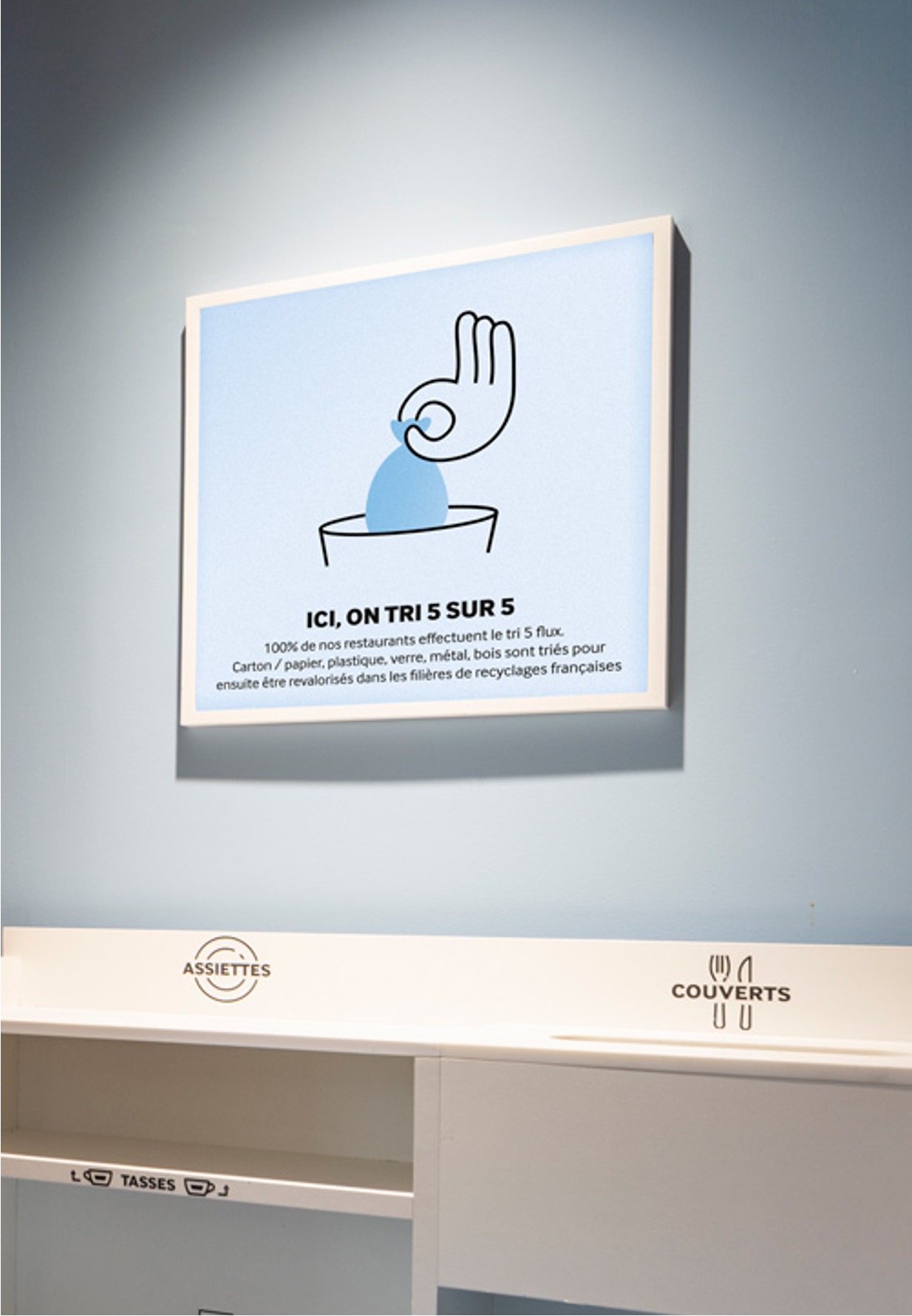
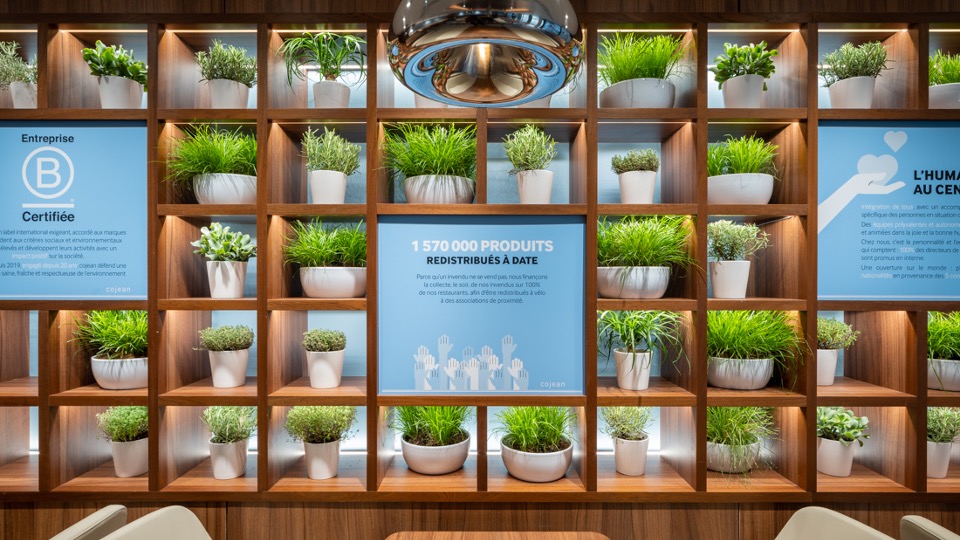
Whether it’s product packaging, the graphic ecosystem, or even the retail store concept, a brand can contribute to overall sustainability, and that can happen on multiple scales! ♻️
CSR: no introduction needed… The important thing to remember is that CSR has become a fundamental element of our society, of our decade. What are the similarities between Corporate Social Responsibility and design? What can design bring to businesses in search of progress? CSR and design have a lot in common. They are both human centric and aim to create products, services, or spaces that are both useful and sustainable. They are also both based on the idea of continuous improvement and innovation.
CSR: no introduction needed… The important thing to remember is that CSR has become a fundamental element of our society, of our decade. What are the similarities between Corporate Social Responsibility and design? What can design bring to businesses in search of progress? CSR and design have a lot in common. They are both human centric and aim to create products, services, or spaces that are both useful and sustainable. They are also both based on the idea of continuous improvement and innovation.
The big question we’re going to ask ourselves is how CSR and design can join forces to create a positive impact on society, consumers and businesses themselves? Because one thing is certain: nowadays, not having a CSR approach is a danger for brands!
CSR encourages companies to take societal dimensions into account, pushing designers to design products and services that contribute to the well-being of consumers while minimizing their impact on the environment. Ultimately, CSR is a guide for us -designers- to create solutions that genuinely meet citizens’ needs.
Today, society and its citizens have asked brands to assert themselves and get involved. Society has the power to act!
————– Julia BEYNET, Branding Director at CBA.
There are several types of design and ways to approach CSR. Let’s start with what touches us most: inclusivity for a more diverse society.
Design emphasizes inclusivity, recognizing the diversity of individuals. Brands are now required to consider the needs of people with disabilities, minorities, and marginalized populations. Such an approach allows to create products and services that are accessible to all, thus promoting a more equitable and harmonious society. To achieve such a result, it’s essential for all companies to involve all their stakeholders in the CSR process. Employees, and stakeholders more broadly, have expectations and needs that companies must listen to and consider. It is thanks to this active listening of stakeholders that brands will develop and imagine relevant and sustainable solutions.
For instance, let’s take Cora, the brand has reviewed its entire internal strategy. To carry out this project, the company has built, hand in hand, the fundamentals of its brand with more than 20,000 employees. A guarantee of well-being in the workplace, listening and collective approach.
For instance, let’s take Cora, the brand has reviewed its entire internal strategy. To carry out this project, the company has built, hand in hand, the fundamentals of its brand with more than 20,000 employees. A guarantee of well-being in the workplace, listening and collective approach.
More and more companies are adopting a circular economy approach, aiming to reduce waste and optimize resource’s use. Design plays an essential role in eco-design, creating sustainable, repairable, and recyclable products while contributing to protect the environment and encourage responsible consumption. This can also lead us to talk about ethics, which questions the social and emotional impact of the products and services designed, which encourages businesses to adopt practices that respect human rights, diversity, inclusion, and equity.
To illustrate this point, let’s talk about Né d’une seule Ferme (new J’achète fermier), the brand has been able to tackle he needle by offering a fair, responsible product that meets the growing and constant demand of consumers to consume locally. In addition, the brand has also listened to the expectations and needs of farmers/producers by allowing them to regain control over their income!
To illustrate this point, let’s talk about Né d’une seule Ferme (new J’achète fermier), the brand has been able to tackle he needle by offering a fair, responsible product that meets the growing and constant demand of consumers to consume locally. In addition, the brand has also listened to the expectations and needs of farmers/producers by allowing them to regain control over their income!
By combining CSR, design, innovation, and progress, brands can adopt a holistic approach that puts humans and the planet at the center of their concerns. This combination offers opportunities to create innovative and sustainable solutions, meeting the needs of citizens while contributing to a better world. By placing CSR at the heart of their strategies, brands can become actors of change, shaping a more responsible and environmentally friendly future.
Designers are here to support this evolution. So yes, we’re not perfect and that’s not the point! No! The goal in a CSR approach is to progress, and to progress together!
“Men who wear makeup are challenging traditional notions of masculinity.” Times are changing, and so are the rules of the game! Let’s put an end to stereotypes and embrace a culture of respect without judgment, allowing everyone to express themselves freely and unapologetically.
In recent years, the market for men’s cosmetics has been booming. According to a Reportlinker study, it was already valued at 38.5 billion euros in 2020 and is projected to reach 50 billion euros by 2026! With unisex, no-gender, or inclusive approaches, the world of skincare and makeup, long reserved for women, is finally opening up to everyone, regardless of gender.
Representation, inclusion, diversity… These are just some of the terms that have emerged in brand communication in recent years. Their common goal? To unite around one concept: the empowerment of individuals and the expression of oneself. In short, empowerment!
Beyond mere aesthetics, design enables brands to convey key messages regarding their stance and commitments to society.
When design is inclusive, it holds transformative power in strengthening communities and acts as a catalyst for positive social change.
Companies are increasingly required to create a space for dialogue where everyone can fully participate, express themselves freely, and empower themselves without compromise!
According to Wunderman Thompson, 90% of individuals now believe that equality is a shared responsibility, and 75% feel that businesses and brands should contribute to solving major societal challenges, such as equality and social justice. Undoubtedly, brands that take action in this direction are the most rewarded!
In fact, 66% of consumers say they are more drawn to buying from companies that take a stand on inclusion and other related issues. Moreover, an increasing number of consumers expect companies to create concrete solutions that promote their empowerment, autonomy, and mental well-being.
But how can this be achieved? Let’s focus on the main pillars, reimagined for the year 2023. ✊

Since the pandemic, awareness around the importance of mental health has become even more relevant, and individuals are turning to well-being resources to maintain balance. Online mental health platforms have been strengthened significantly to meet this growing demand, empowering people to regain control over their lives and improve their quality of life.
Empowering minorities by breaking taboos surrounding sexuality, is a must.
Over the past decade, conversations about female and queer pleasure have become increasingly accepted, and the benefits of a healthy sexuality on physical and mental well-being are widely recognized. Numerous platforms to help consumers learn more about their mental, physical, and sexual health are flourishing!
By designing products and experiences tailored to diverse gender identities, sexual orientations, and physical abilities, more and more brands are aligning themselves with the concept of well-being. Inclusive 3.0 platforms enable users to explore and embrace their sexuality in a safe, informed, and empowering manner.


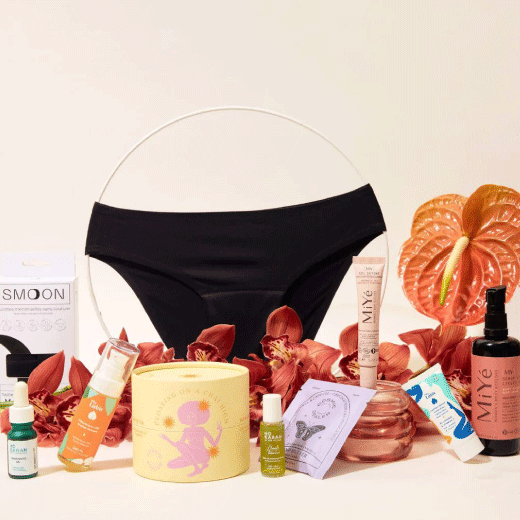
Sexuality, breastfeeding, and postpartum should not be taboo subjects; the filters must come down. With this approach, we aim to modernize intimacy and remind everyone that pleasure is allowed for all.
EMJOY is a holistic sexual well-being application that offers a playlist of guided audio practices, enjoyable meditations, and erotic stories tailored to women, far from the male gaze! By providing educational content, the podcasts convey a positive message about sexuality to their listeners, fostering self-acceptance.
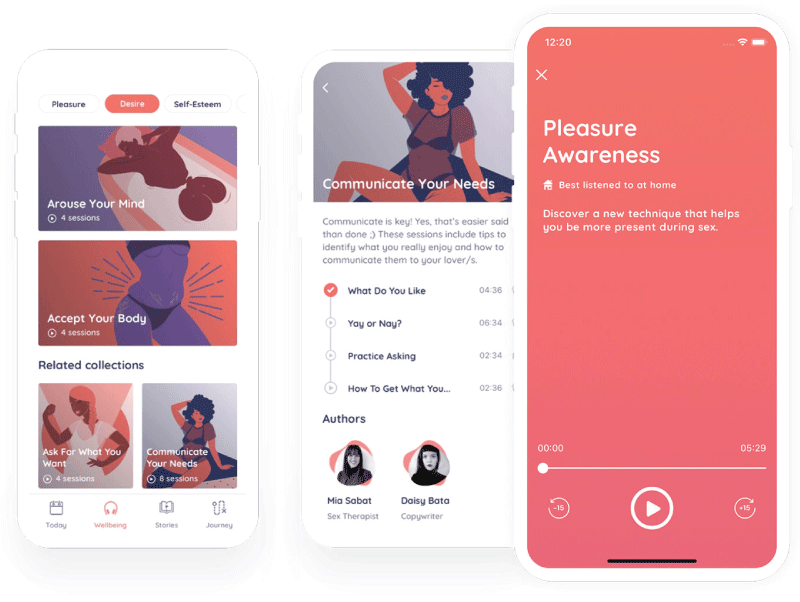
Developed by doctors and psychologists, ROSY represents a new model of sexual health for women that erases shame and isolation. It offers listening support and a multidisciplinary approach that accompanies users at every stage of their sexual lives.
Let’s put an end to judgments and embrace self-love!
From the blend of art and commitment comes social design. It involves using design as a tool to address social issues and enhance the quality of life within communities.
A great example of social empowerment is the highly contested market of menstrual panties in recent years. With their comfort and eco-friendliness, menstrual panties have dethroned traditional disposable menstrual products among many women.


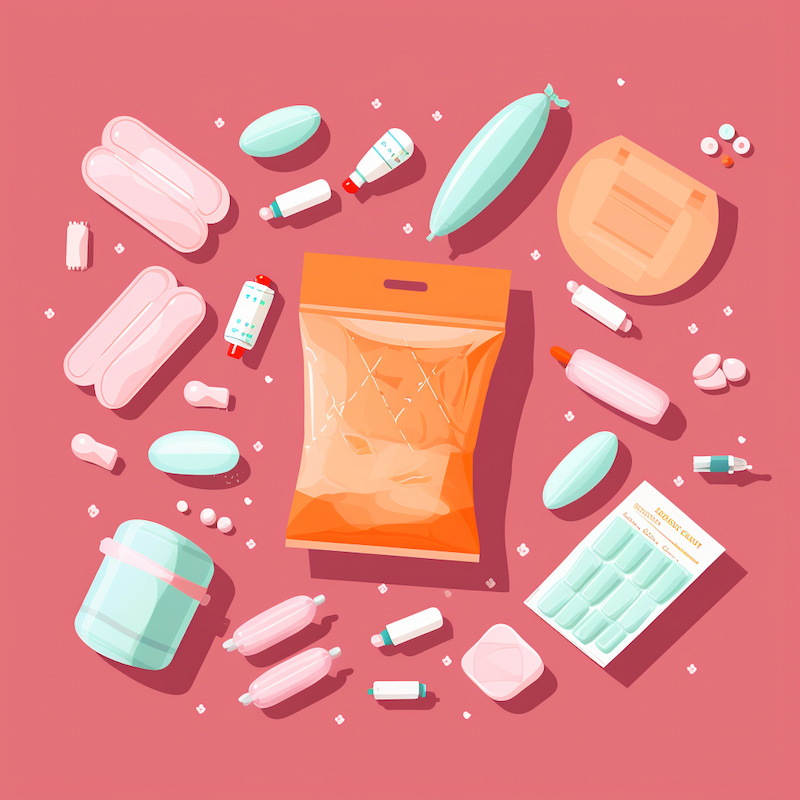
Forty-five billion feminine hygiene products are consumed worldwide each year, with an estimated decomposition time of 500 to 800 years. Approximately 13,320 menstrual products are used during a woman's lifetime, resulting in around 1,650 euros in expenses. In contrast, a menstrual panty costs between 30 and 35 euros and has a lifespan of five to seven years.
The harmful effects of tampons and pads on women’s health, particularly due to the presence of dangerous chemical compounds, have led to a growing ecological and economic awareness.
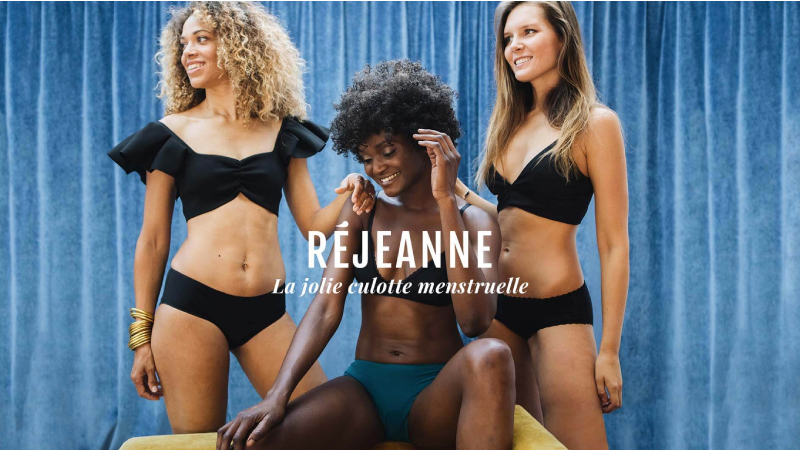
As a pioneer of made in France menstrual lingerie, RÉJEANNE offers a range of organic cotton panties tailored to different flow levels. With its patented technology and OEKO-TEX certification, the Réjeanne panty provides unprecedented comfort and allows freedom of movement without compromising on bodily health.
Being free, eco-friendly, and economically conscious is a winning choice. Ladies, the time for change has come!
Conscious of the societal and environmental impact of their actions, brands are increasingly turning to design to convey their values and commitments. With its ability to tell stories and convey powerful messages, design provides companies with a unique platform to raise awareness among consumers about crucial current topics.
So, we’ve all understood: through technological innovations and global awareness, design empowers individuals to regain control of their lives, well-being, and leisure. And the brands that will be most rewarded are undoubtedly those that continue to create inclusive, accessible, and representative solutions that cater to the diversity of needs and experiences of each individual. We are the protagonists! ✊
What is the packaging of the future? A complex question, since packaging trends are constantly evolving! So it’s always worth analyzing and understanding them. With eco-responsible packaging, smart packaging, minimalist packaging and playful packaging, it’s hard to know where to turn!
Let’s focus today on connected packaging.
Simply, it’s a more intelligent packaging, using technological levers to enable genuine interaction with consumers. It’s a packaging in tune with the times, responding to a growing consumer demand for personalization and interactivity. Ultimately, packaging is one of the most important points of activation for any brand, since it bridges the gap between the real world and the digital one, offering a differentiating and memorable experience.
Simply, it’s a more intelligent packaging, using technological levers to enable genuine interaction with consumers. It’s a packaging in tune with the times, responding to a growing consumer demand for personalization and interactivity. Ultimately, packaging is one of the most important points of activation for any brand, since it bridges the gap between the real world and the digital one, offering a differentiating and memorable experience.
————– Appetite Creative, Second annual connected packaging survey
Appetite Creative, specialized in B2B marketing, connected packaging and customer engagement experiences at scale, recently published in February of this year its second annual connected packaging survey. A study highlighting the growing popularity of connected packaging, both among companies and consumers. 81% of these surveyed said they had used connected packaging (vs. 54% in 2022) and 57% believe that connected packaging is increasingly important for communicating with and educating customers.
Digital makes it possible to extend the functions of packaging. It becomes useful, practical and gives consumers a much more interesting experience.
Connected packaging provides transparency, for the consumer but also for the brand. Thanks to the connected packaging, who is connected to the supply chain management system, the brand can track the product’s journey. For the consumers, it allows to know more about the product’s origin and its quality. It’s in fact a huge factor of reassurance. It’s interesting to see how powerful a connected packaging can be!
Thanks to connected packaging, the consumer has easy access to product information, advice, or additional support services. Brands also uses connected packaging to raise awareness on sustainability and recycling. Sharpend, a company supporting global brands deliver connected excellence, accompanied and digitized Yeo Valley product portfolio with QR-enabled connected packaging. Sharpend thanks to QR code allows consumers to access to content such as information on the brand and the product and details on product recycling.
Source: Sharpend
If we think now of the design, the design of packaging keeps evolving! On one hand connected packaging allows brands to create original and imaginative consumers journey and on the other hand, it allows consumers to connect to creative experiences. Thanks to « embedded sensors », customer can be transported in an amazing augmented reality experience where the brand, through augmented reality, expresses its identity, its codes, and creates memorable experiences for customers with the goal of engaging and differentiating itself.
The Australian wine brand, 19 crimes, is using augmented reality to bring its bottles to life. On Each bottle features a historical figure. Using the brand application, the character comes to life and consumers can find out more about him or her. The brand extends its brand universe to the very end, using augmented reality.
Source : 19 Crimes website.
If we think now of the design, the design of packaging keeps evolving! On one hand connected packaging allows brands to create original and imaginative consumers journey and on the other hand, it allows consumers to connect to creative experiences. Thanks to « embedded sensors », customer can be transported in an amazing augmented reality experience where the brand, through augmented reality, expresses its identity, its codes, and creates memorable experiences for customers with the goal of engaging and differentiating itself.
Source : 19 Crimes website.
The Australian wine brand, 19 crimes, is using augmented reality to bring its bottles to life. On Each bottle features a historical figure. Using the brand application, the character comes to life and consumers can find out more about him or her. The brand extends its brand universe to the very end, using augmented reality.
Connected packaging is also an amazing tool to gather data and consumer insights. This data allows them to constantly and in a real–time, adapt their strategy with the goal of reaching their target audience. But how do they collect data? For example, thanks to a QR code on the pack, consumers can have access to special offers that encourage them to return to the store. This is a clever way to gather data and create engagement with the consumer. We obviously remember the iconic Coca Cola campaign « Share a Coke », imagined by Ogilvy. The brand commercialized bottles with over 150 of the most common names by country. A QR code on the bottles takes consumers to the Coca Cola website to win personalized cans or to give personalized virtual bottles to friends. A successful campaign that increased the Coca Cola group’s sales by 2% in the US.
Source: Share A Coke, Ogilvy Sydney
Source: Share A Coke, Ogilvy Sydney
Connected packaging is also an amazing tool to gather data and consumer insights. This data allows them to constantly and in a real–time, adapt their strategy with the goal of reaching their target audience. But how do they collect data? For example, thanks to a QR code on the pack, consumers can have access to special offers that encourage them to return to the store. This is a clever way to gather data and create engagement with the consumer. We obviously remember the iconic Coca Cola campaign « Share a Coke », imagined by Ogilvy. The brand commercialized bottles with over 150 of the most common names by country. A QR code on the bottles takes consumers to the Coca Cola website to win personalized cans or to give personalized virtual bottles to friends. A successful campaign that increased the Coca Cola group’s sales by 2% in the US.
————– Appetite Creative, Second annual connected packaging survey
More and more brands are investing in this marketing tool. According to the Appetite Creative study, 88% of respondents plan to increase their spending in 2023. This percentage was of 59% in 2022.
Connected packaging is therefore an opportunity for brands to invest in an operational, strategic, and creative tool. It enables them to gather data, establish and adapt their marketing strategies in real time, and offer a superb creative experience to engage consumers.
Did you know that 40 million tons of plastic are discharged into the environment every year?
Air pollution, the increasing presence of plastics in our oceans… Our human activities endanger numerous ecosystems and threaten our own existence. In a rapidly changing world where environmental issues are more crucial than ever before, design emerges as a key player in preserving our planet.
Beyond mere aesthetics, design provides an opportunity to rethink our patterns of consumption and production. Acting with design, yes, but how? Let’s explore.

According to Ipsos (2022), nearly 60% of French people plan to eliminate excessive packaging to fight climate change – a significant percentage that would encourage businesses to integrate more eco-design into their production methods. In the face of growing environmental impact, eco-friendly design plays a crucial role in waste reduction.
The use of recyclable materials enables eco-designed packaging to drastically reduce the amount of plastic used. It’s time for biodegradable, compostable, and recyclable packaging to take center stage, offering thoughtful alternatives to single-use items.

Focus on Unbottled, the emerging made-in-France brand that defies single-use. Committed to nature-friendly cosmetics, the brand offers a variety of solid products for the face, body, hair, and zero-waste accessories, all designed with respect for nature and the ocean.
Not only is Unbottle dedicated to nature, but also to the skin! Beyond biodegradable packaging, their products are certified vegan, free from chemicals, and cruelty-free. Since its inception, Unbottled claims to have already saved 1 million plastic bottles. It’s proof that we can both smell good and do good for the planet!
Design is also a powerful visual language that has the ability to capture attention and convey impactful messages in favor of the environment. From striking visuals to informative packaging, design enables the public to be aware of environmental issues and encourages more planet-friendly behaviors. Beyond aesthetics, design becomes a strong medium for communication and social mobilization.
According to the UN, 9 million tons of plastic are thrown into the ocean every year!
Pure Ocean, a French foundation committed to ocean research and conservation programs, is dedicated to preserving marine biodiversity. With a mission to raise awareness among consumer-activists about waste collection, the foundation sought the assistance of CBA Design for branding support for their new brand: La Goutte Bleue (The Blue Drop).
La Goutte Bleue is a bag made from recycled materials, designed for collecting waste on beaches, in cities, countryside, mountains… before it reaches the sea.
From creating the visual identity of the concept to designing the packaging, La Goutte Bleue was born to the delight of consumer-activists who want to make a positive impact in preserving natural resources. Vamos a la playa!
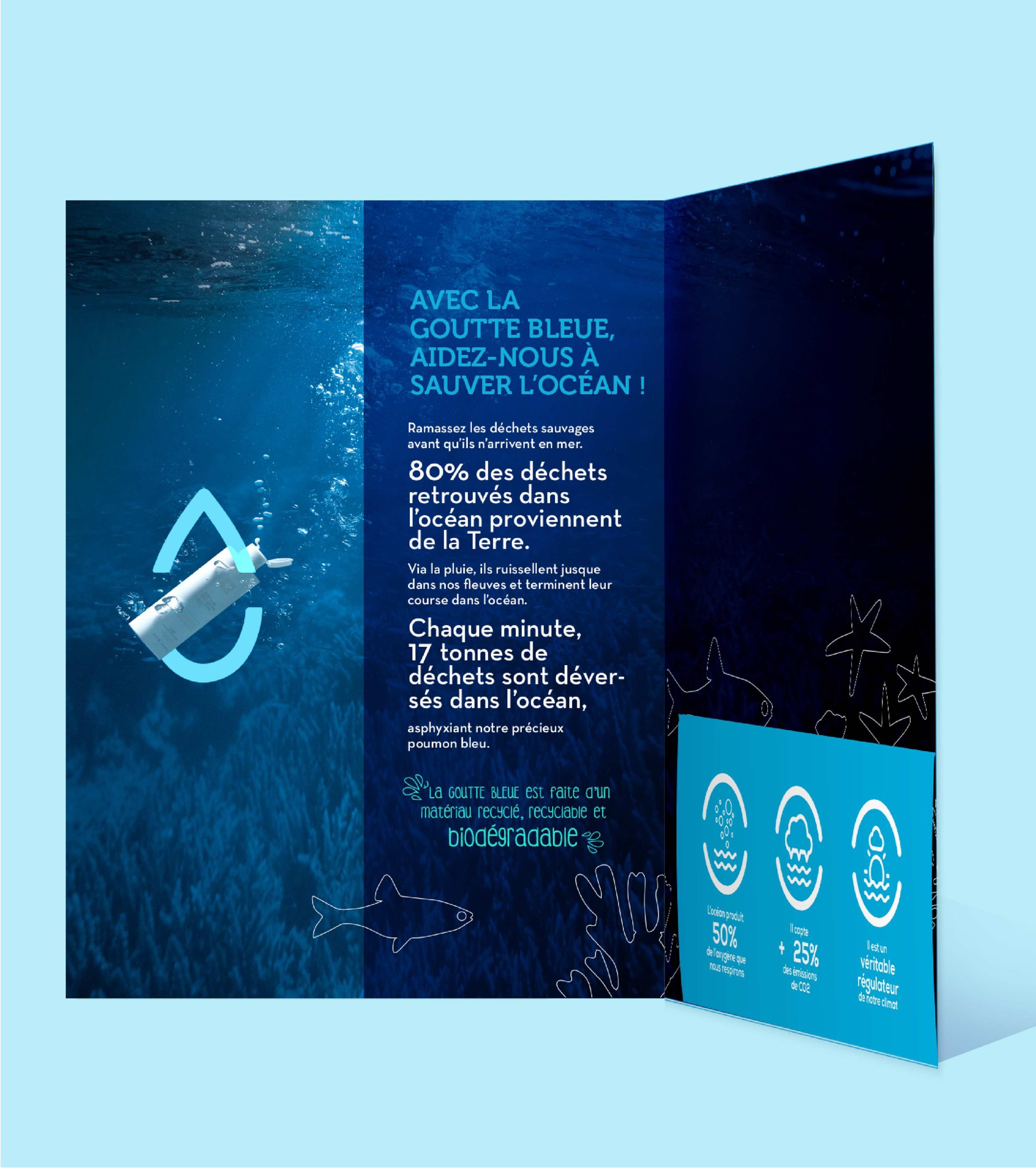
As a rapidly transforming sector, the retail industry has successfully adapted to growing ecological awareness by integrating environmentally friendly practices into all aspects of the retail process. From the products sold to the construction materials used, sustainable retail actively takes part in the Corporate Social Responsibility (CSR) initiatives of brands that have embraced it.
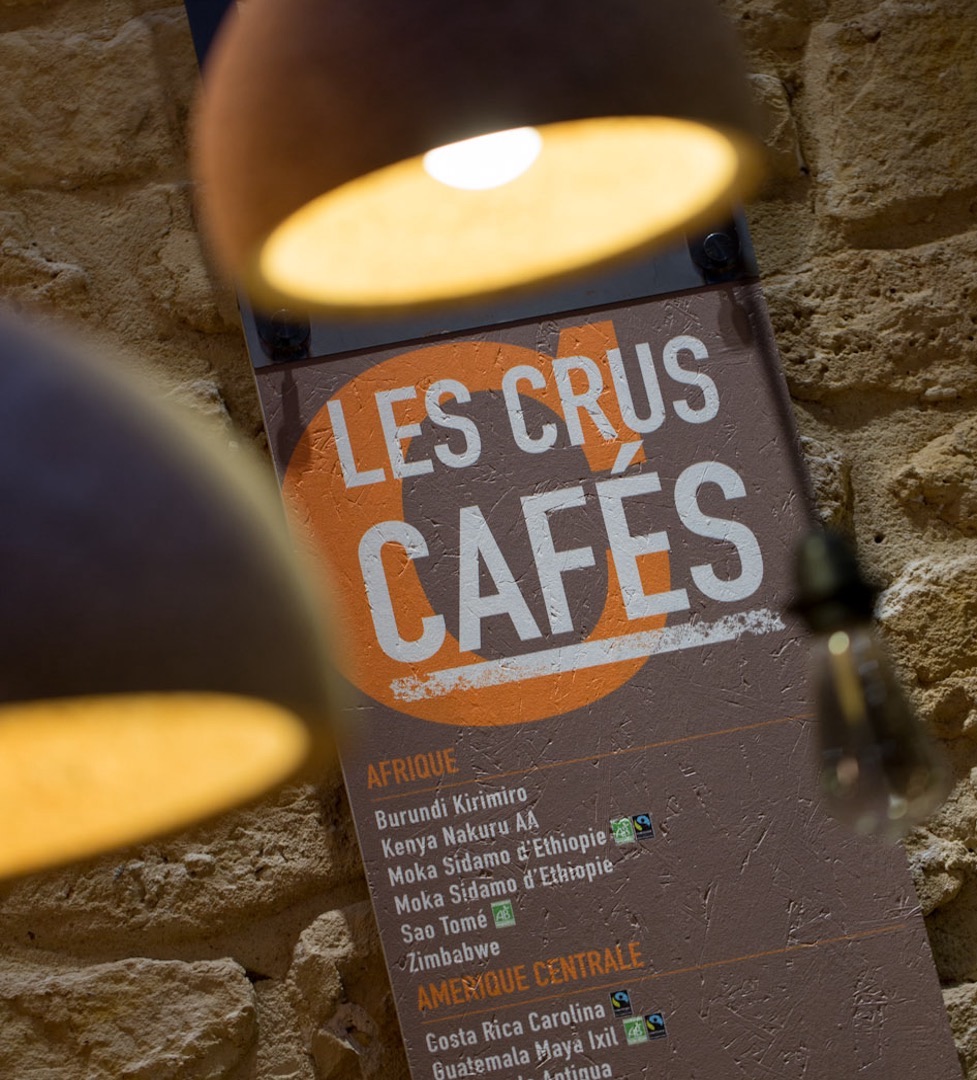
Focus on Malongo, a pioneer in promoting fair trade coffee and tea, which enlisted the expertise of CBA to revitalize its image and boost sales through a retail concept. The brand’s sustainable approach is embodied in:
This innovative concept has been implemented internationally, in Europe and Asia. For Parisians, the boutique can be found at 50 Rue Saint-André des Arts. Get your Navigo passes ready!
Whether through eco-design, awareness, or circularity, we all understand it: design is a superhero for the planet. A true ally of the environment, it undeniably plays a major role in the transition towards a more sustainable way of life.
What about you? What are you doing to save our planet? ♻️